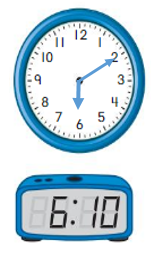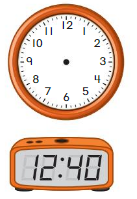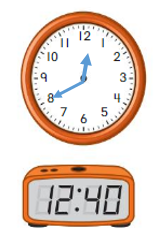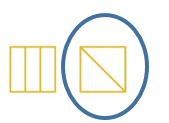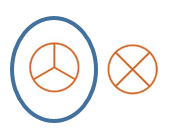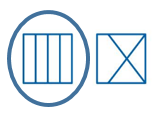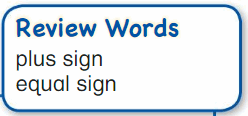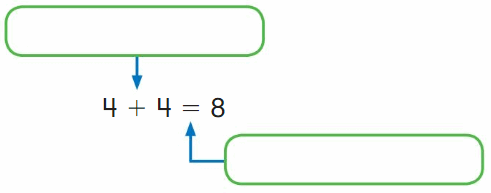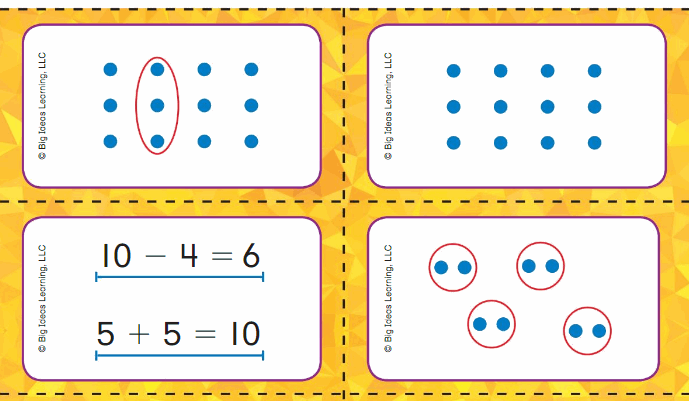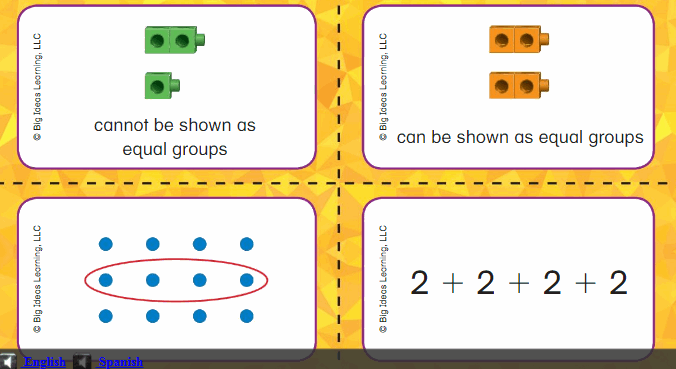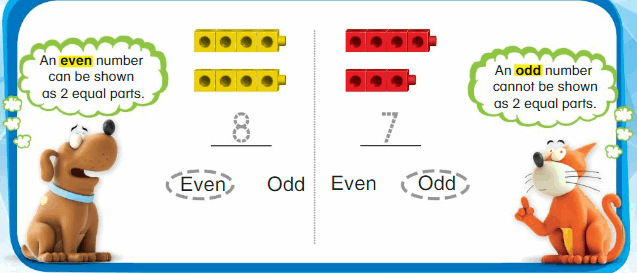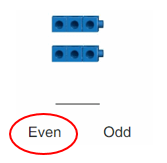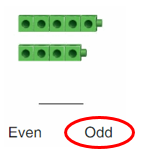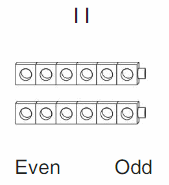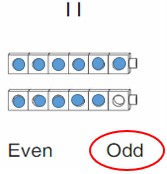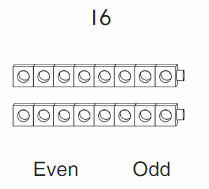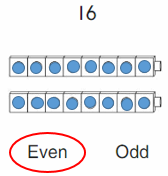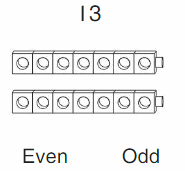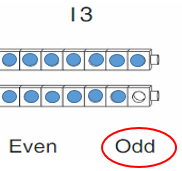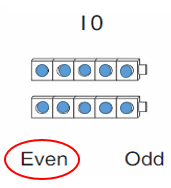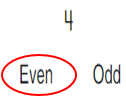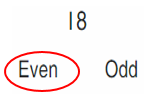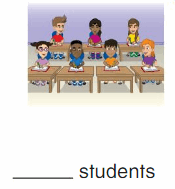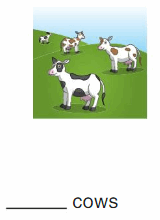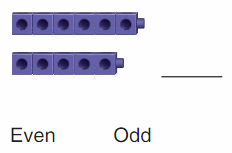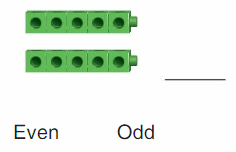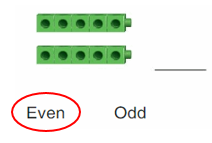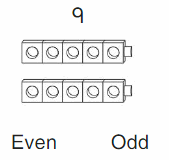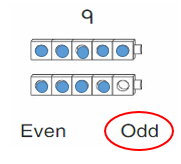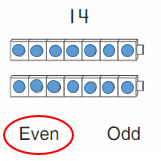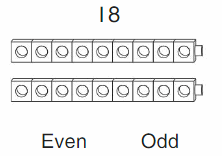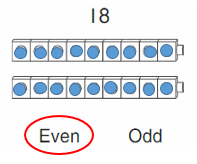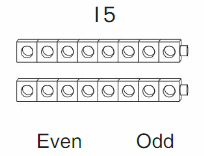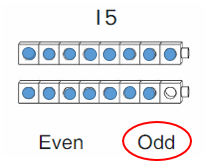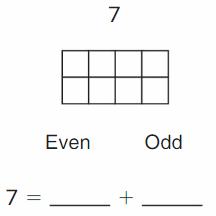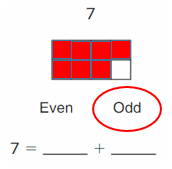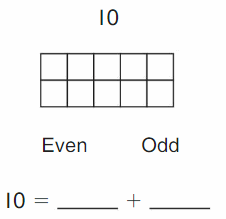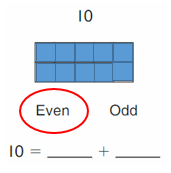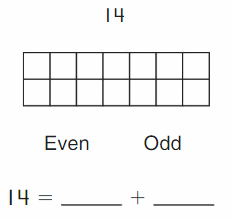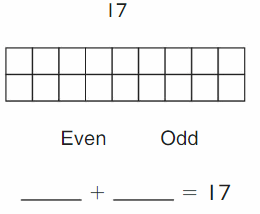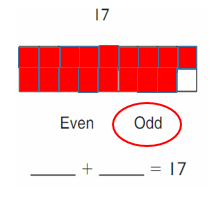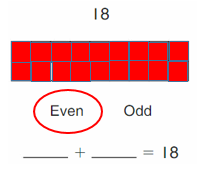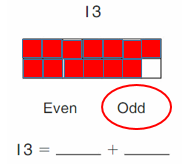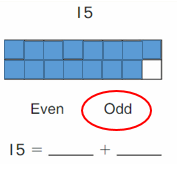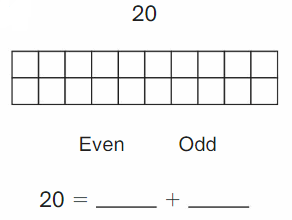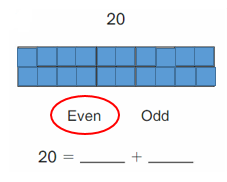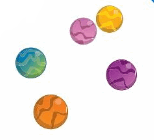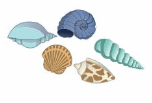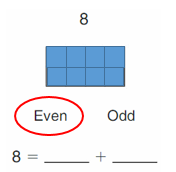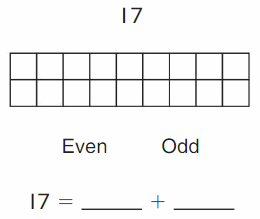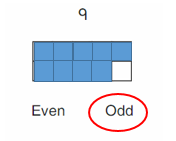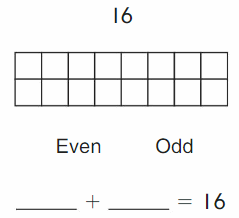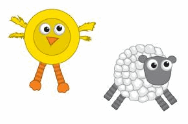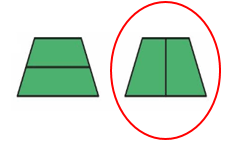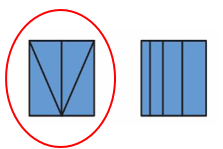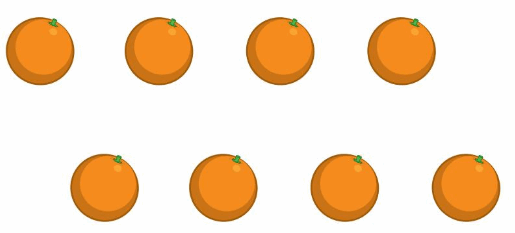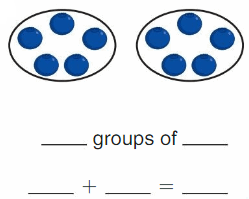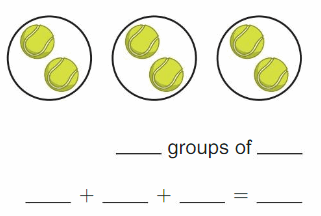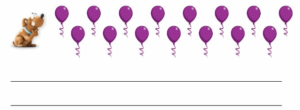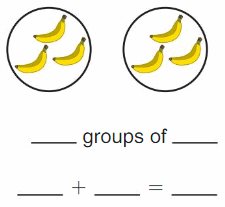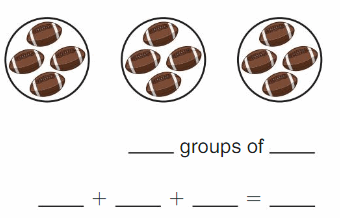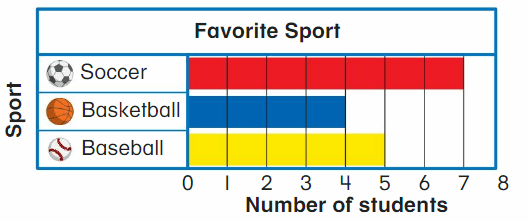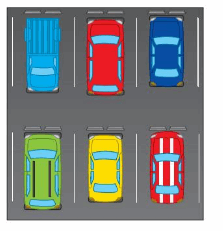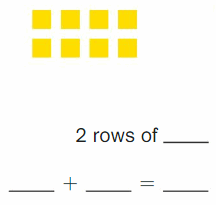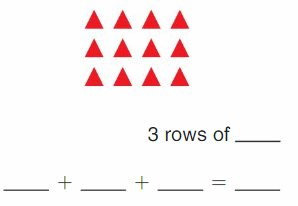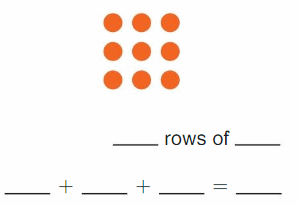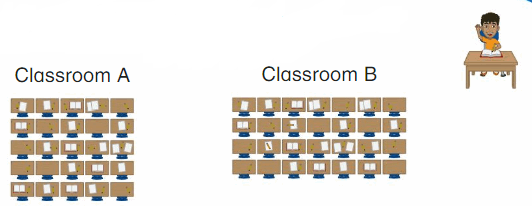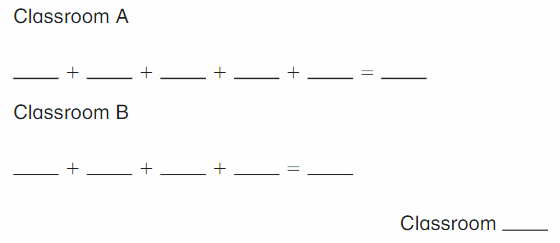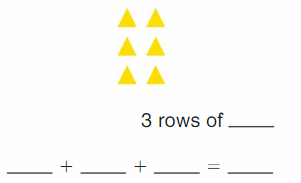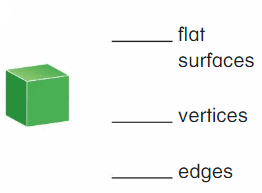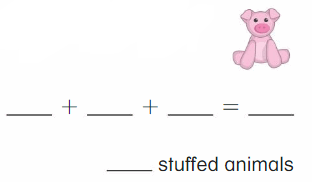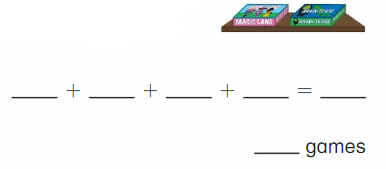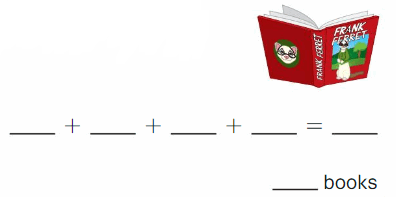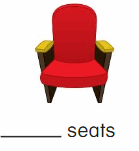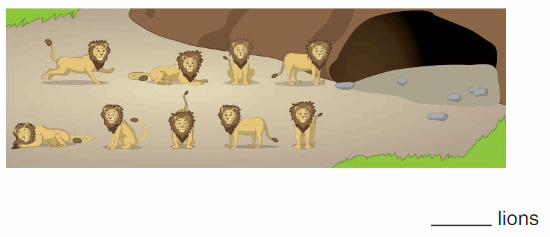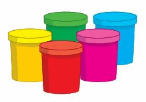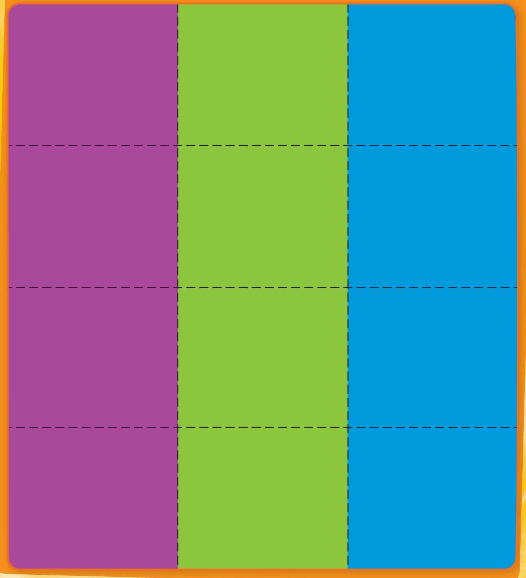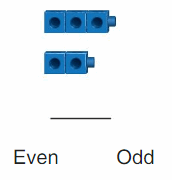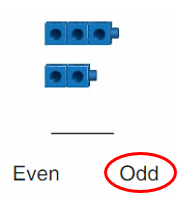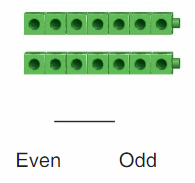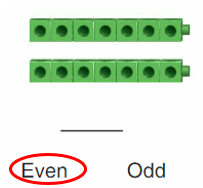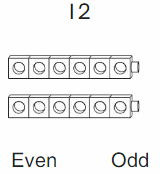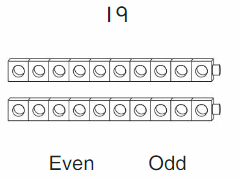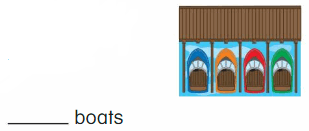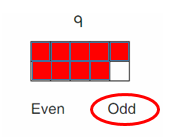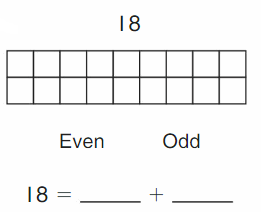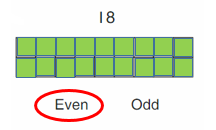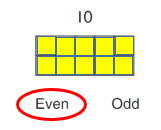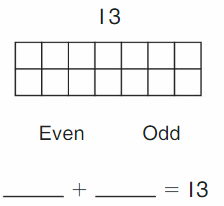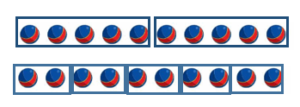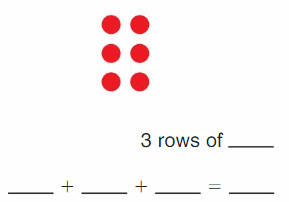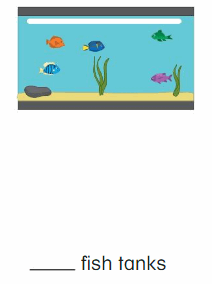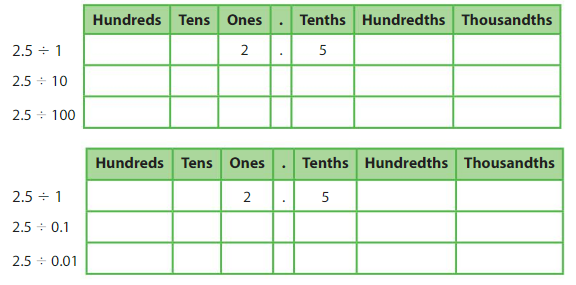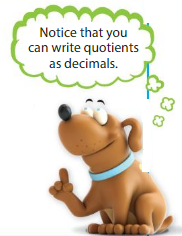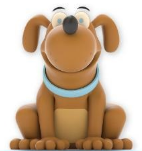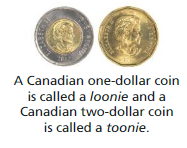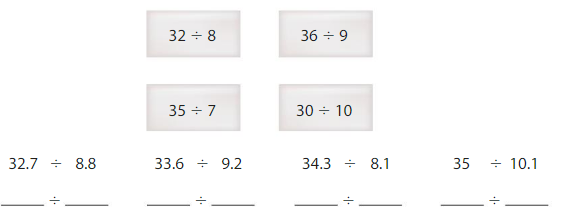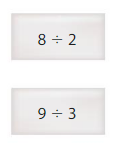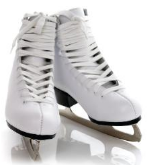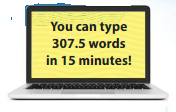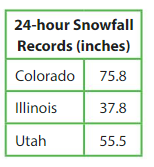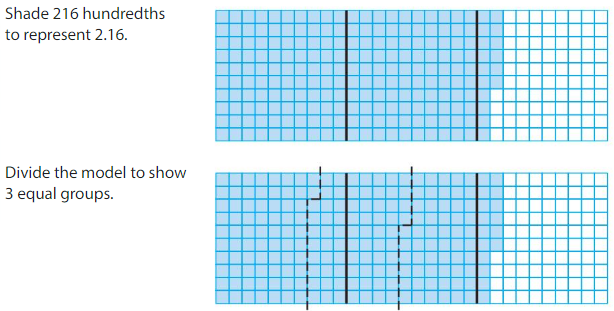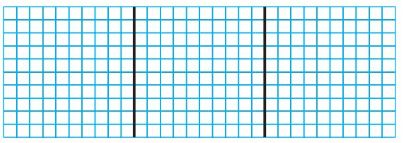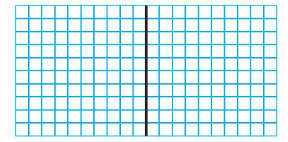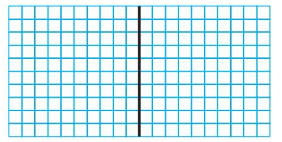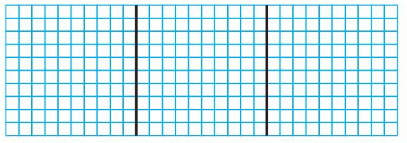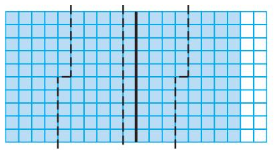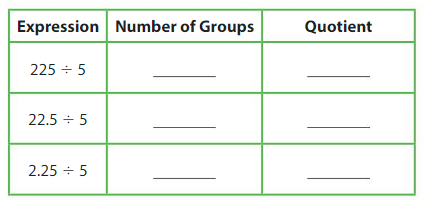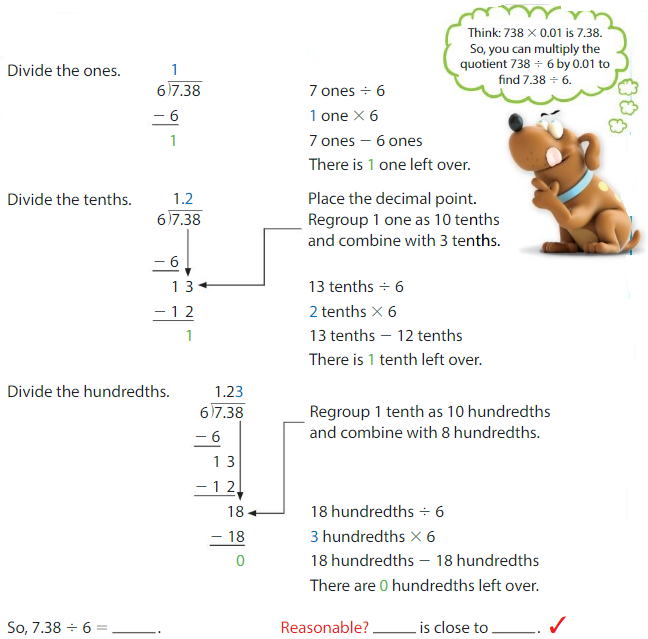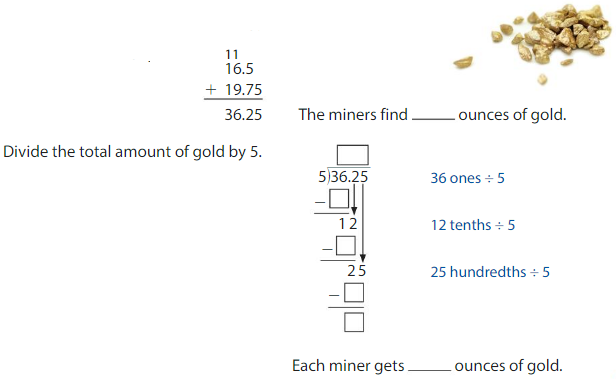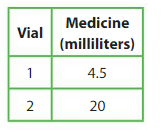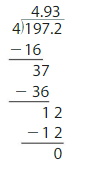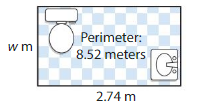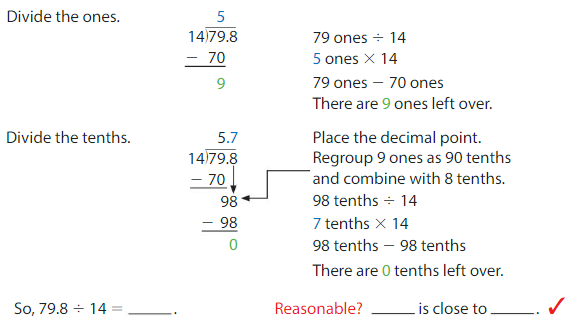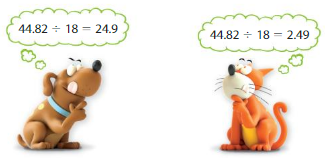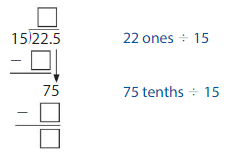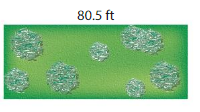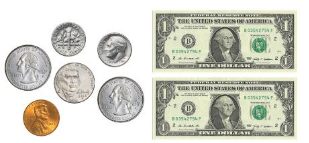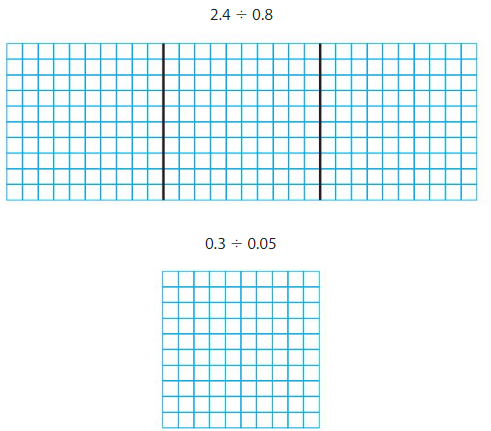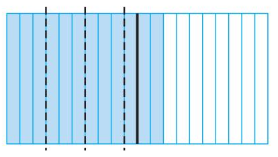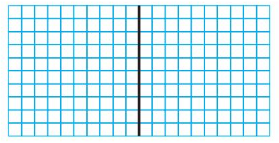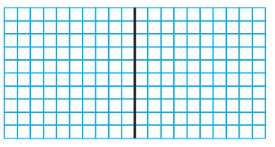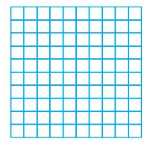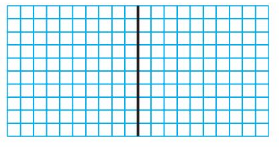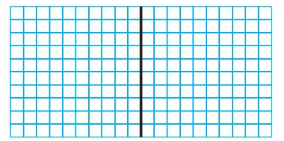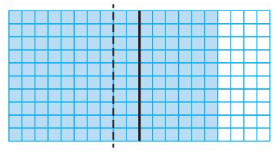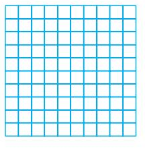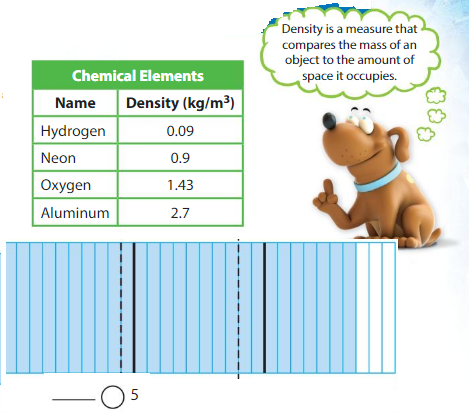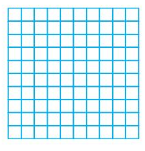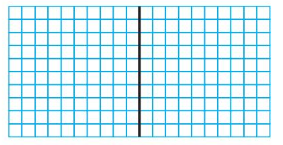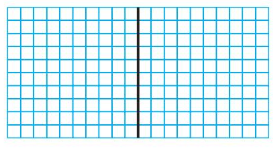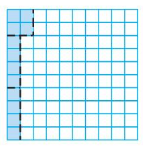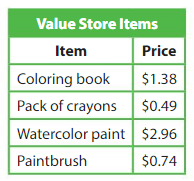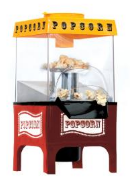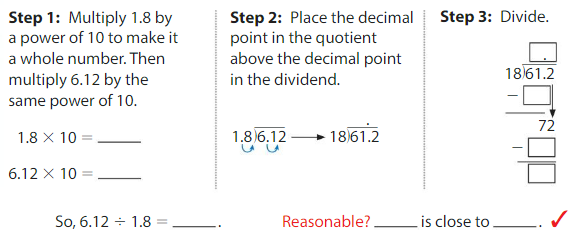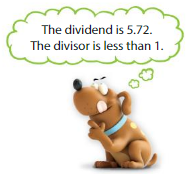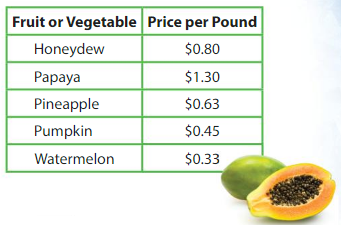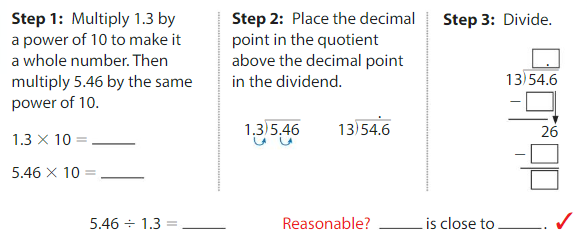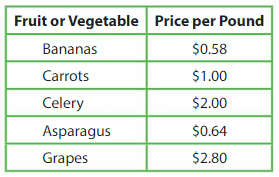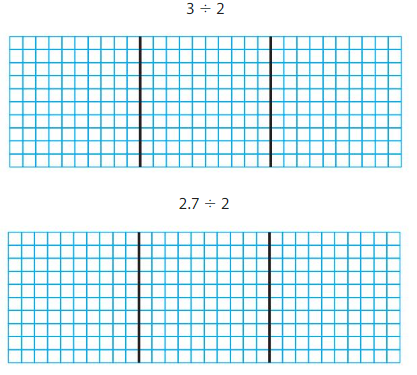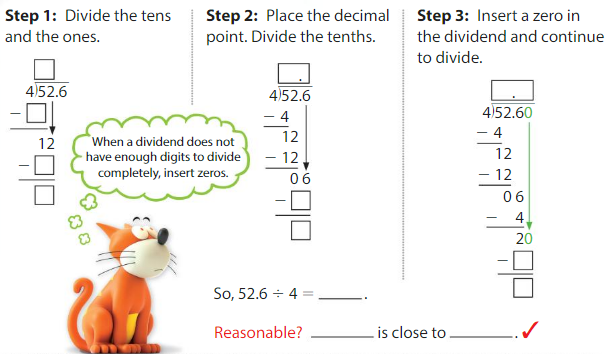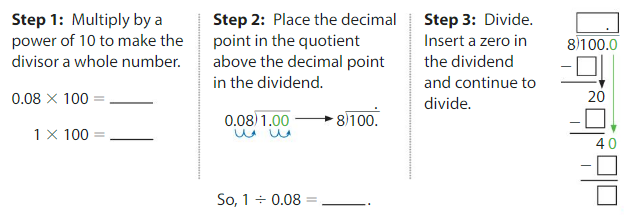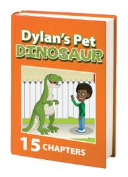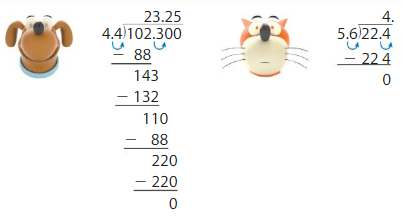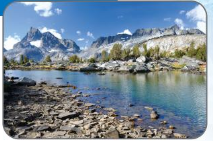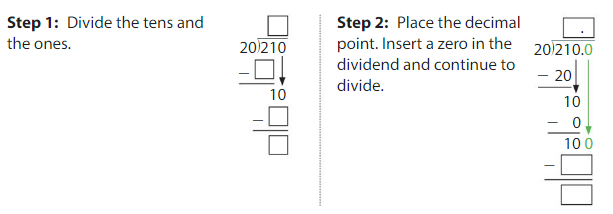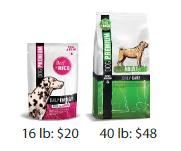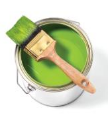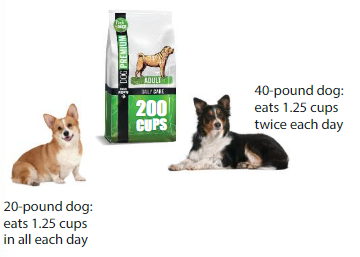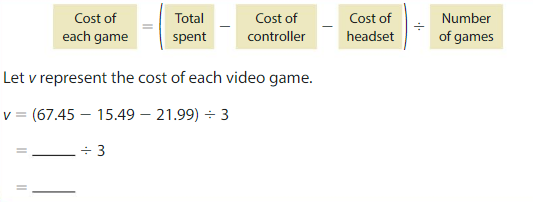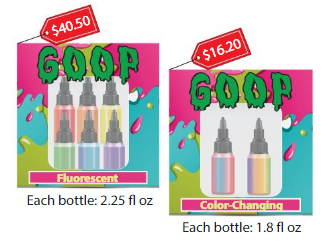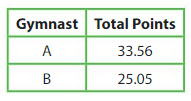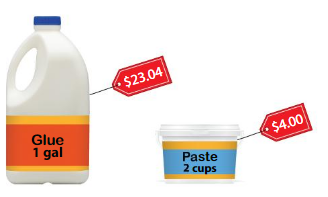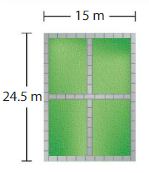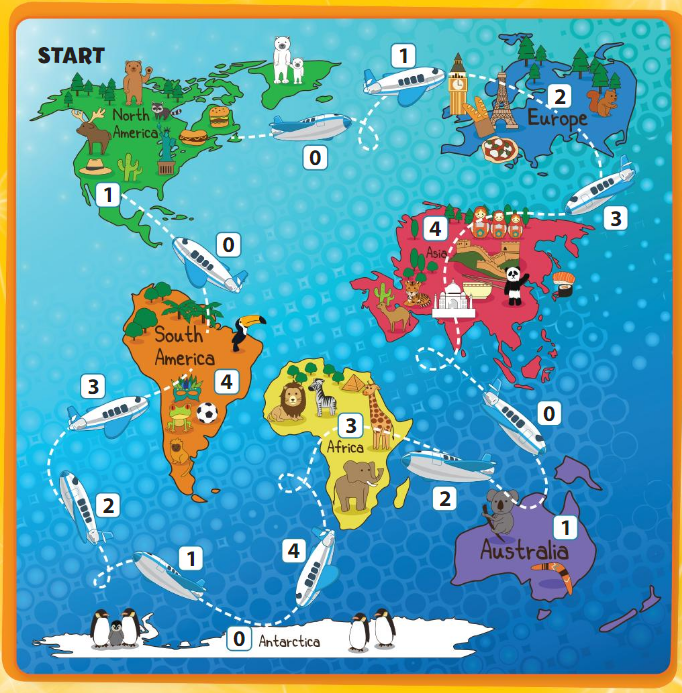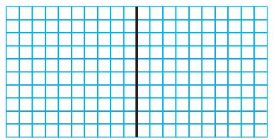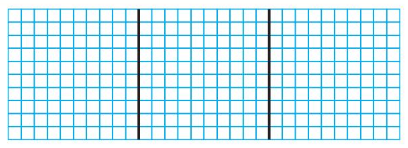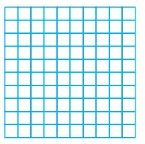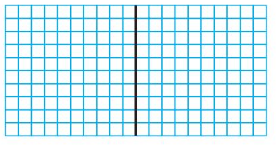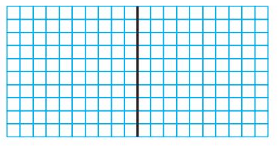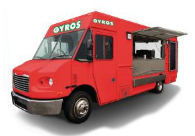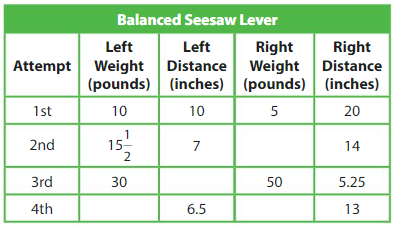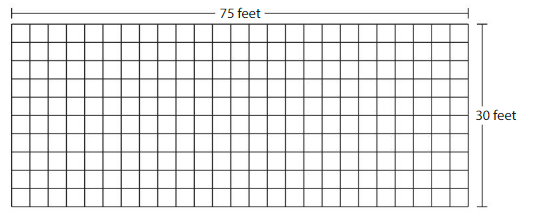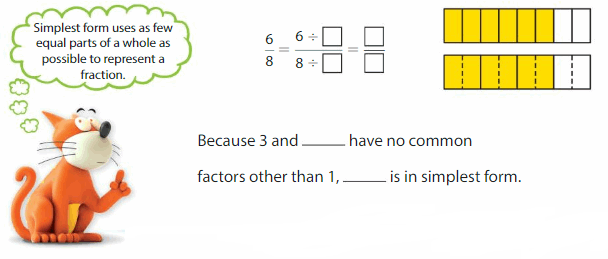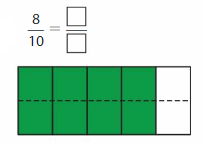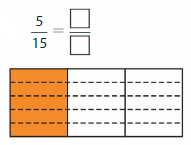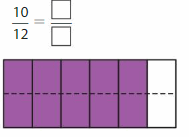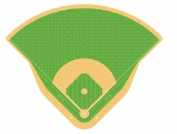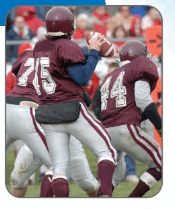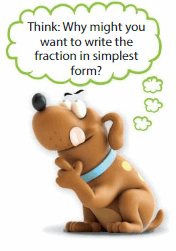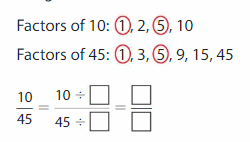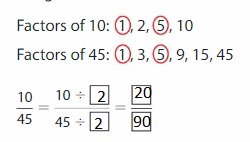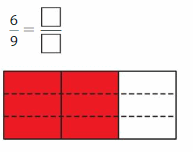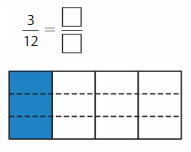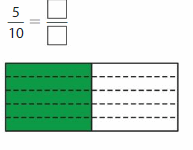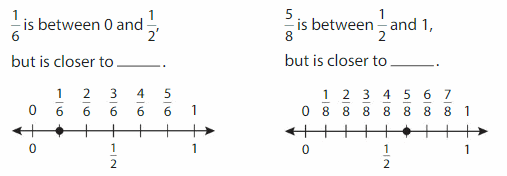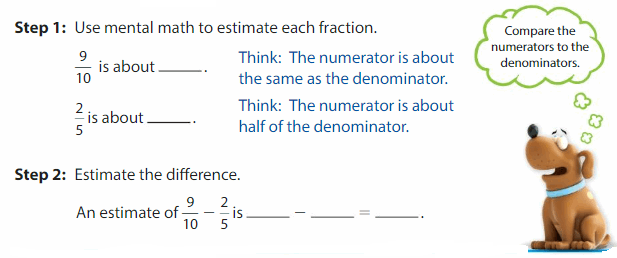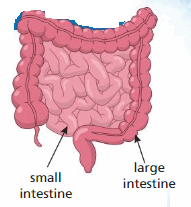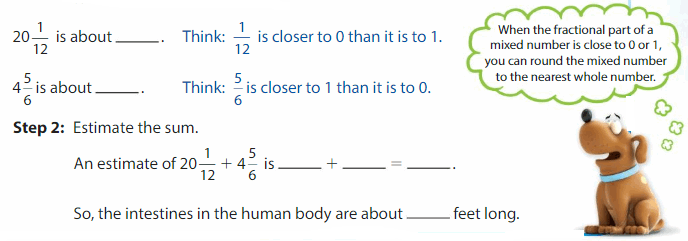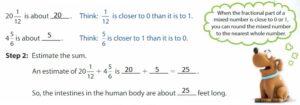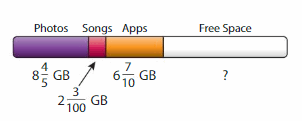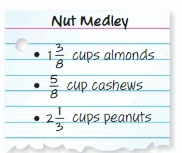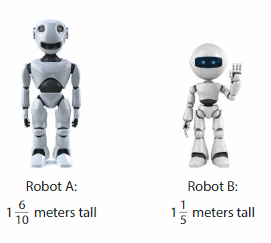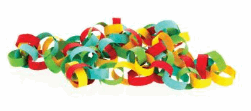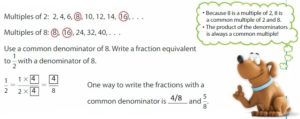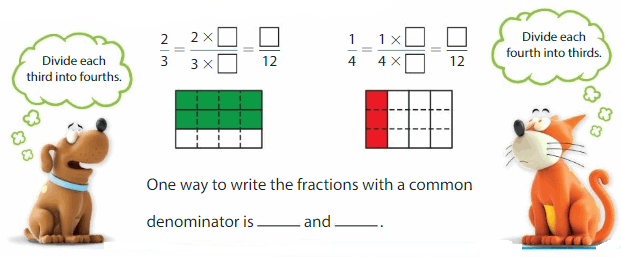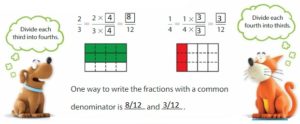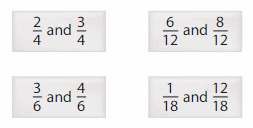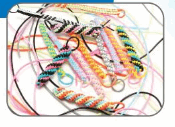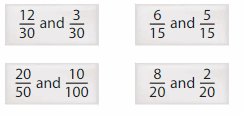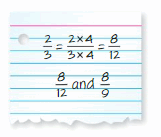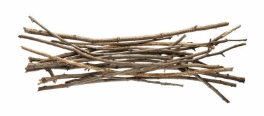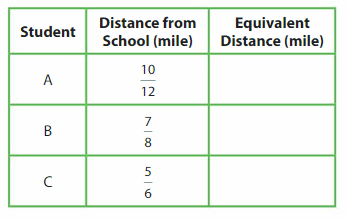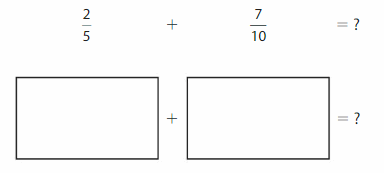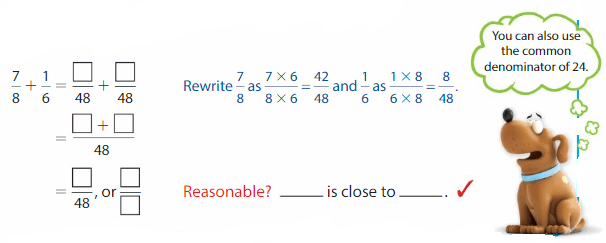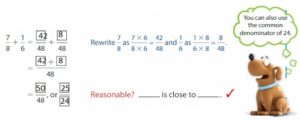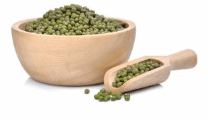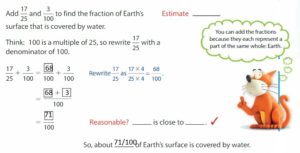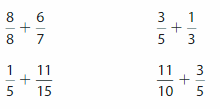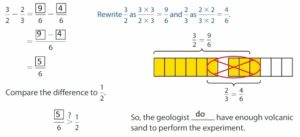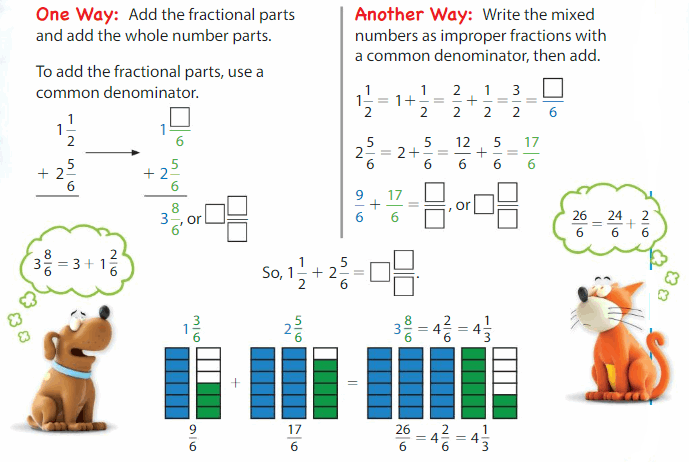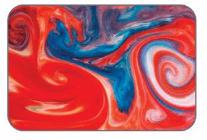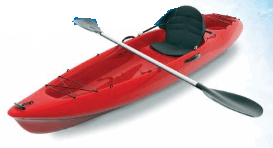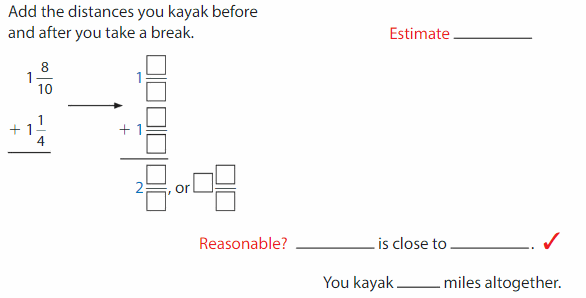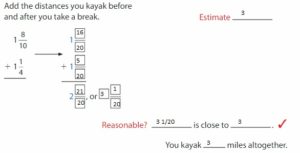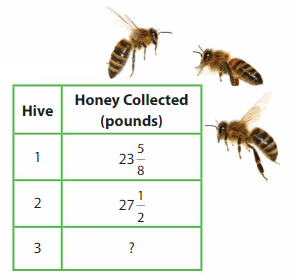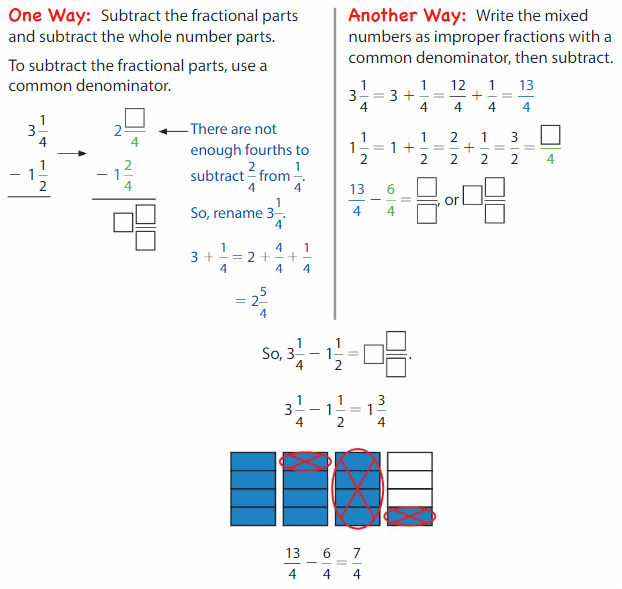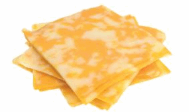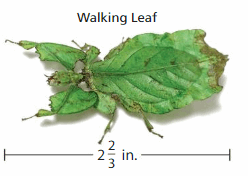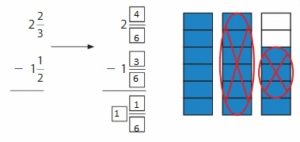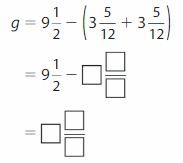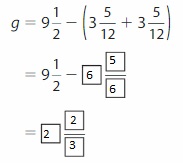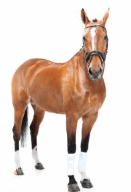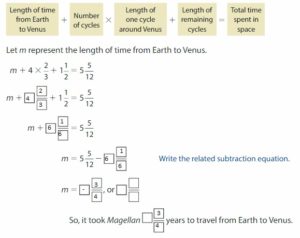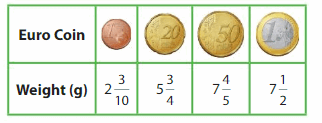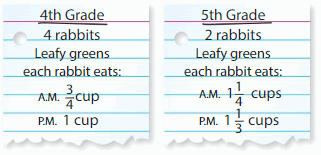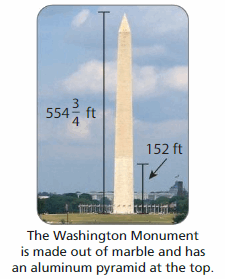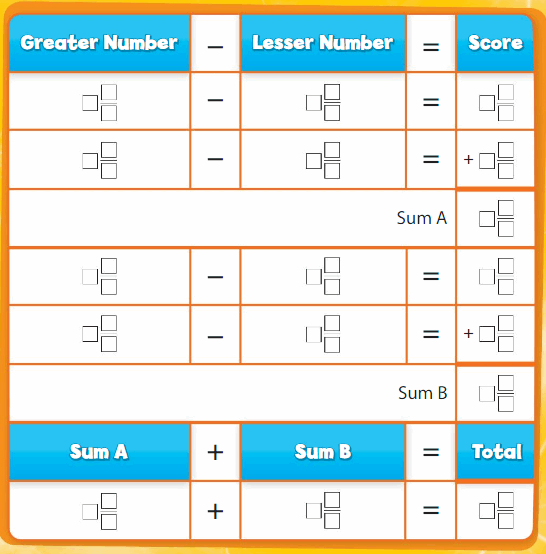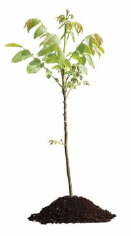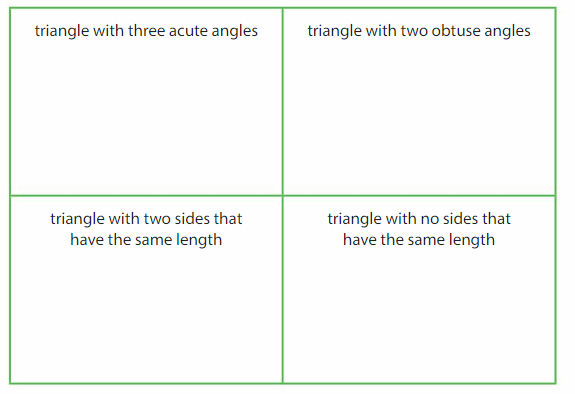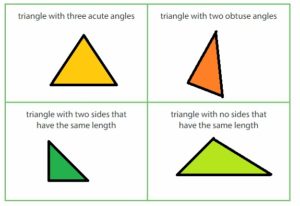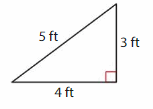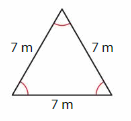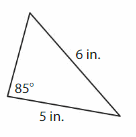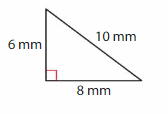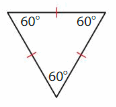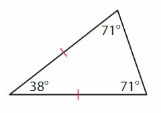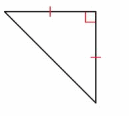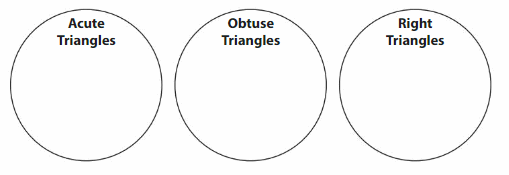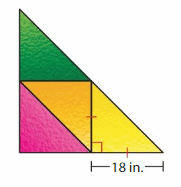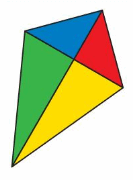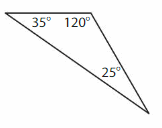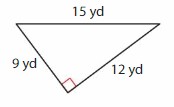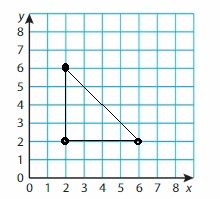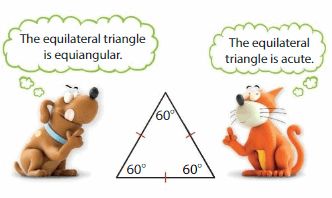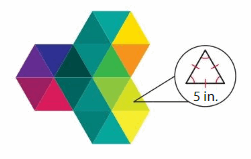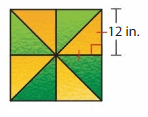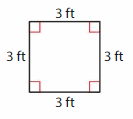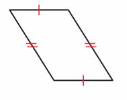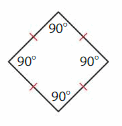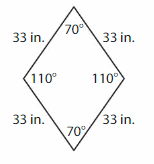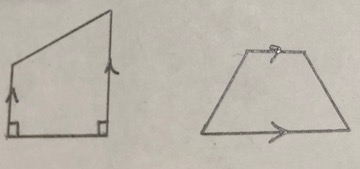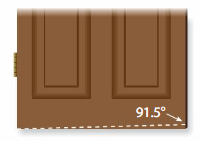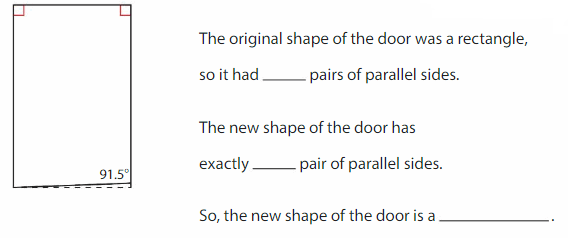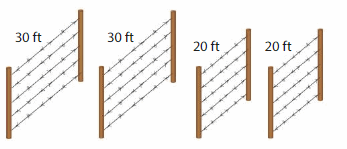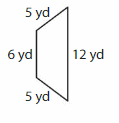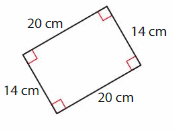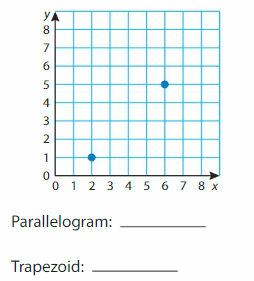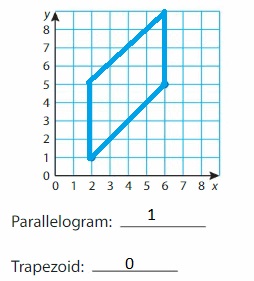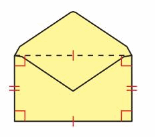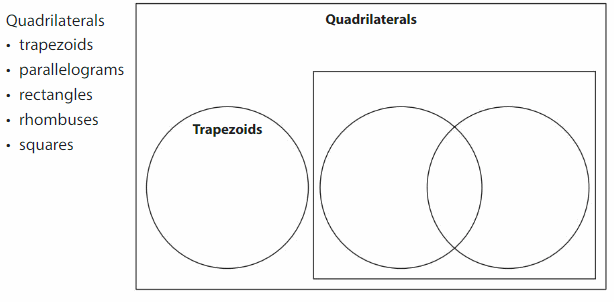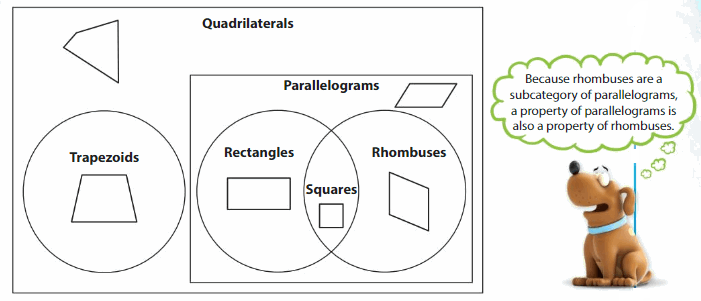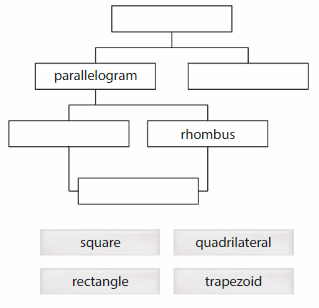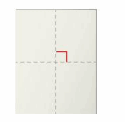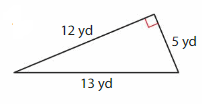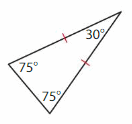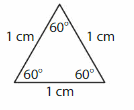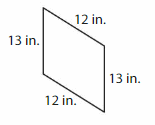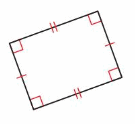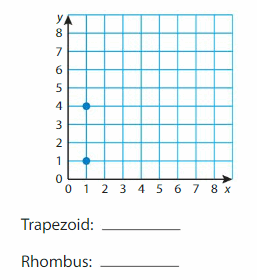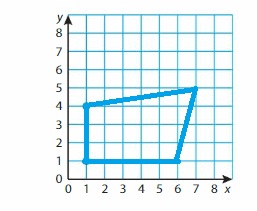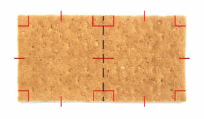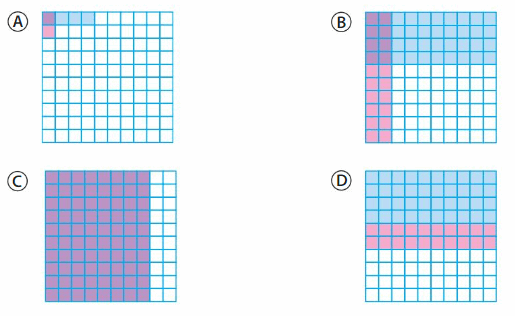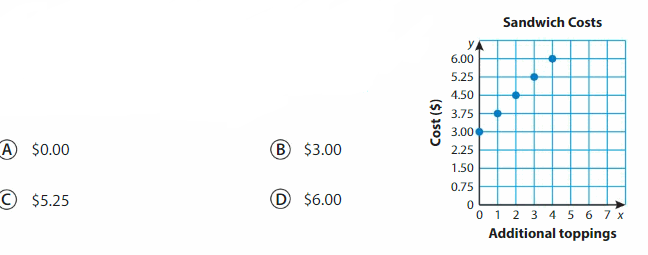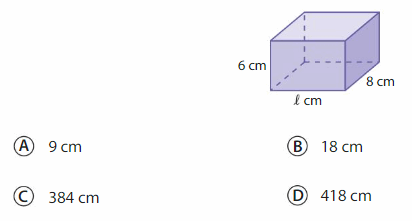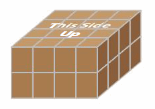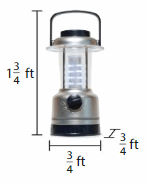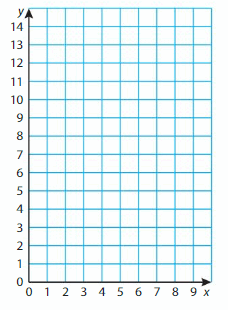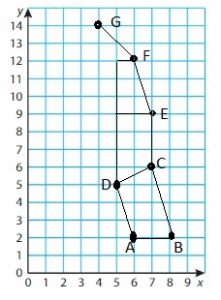The students who are willing to become masters in maths are suggested to follow our Big Ideas Math Book 2nd Grade Solution Key Chapter 15 Identify and Partition Shapes. You can get free access for Big Ideas Math Answers Grade 2 Chapter 15 Identify and Partition Shapes topic wise on this page. Click on the links given below to start the preparation for the exams.
Big Ideas Math Book 2nd Grade Answer Key Chapter 15 Identify and Partition Shapes
It is essential for the students to have the best material to study for the exams. Enhance the subject knowledge and practice as much as possible using the Big Ideas Math Grade 2 Answer Key Chapter 15 Identify and Partition Shapes. Every concept is provided with a brief solution in order to make your preparation effective. You will develop an interest to learn Math on your own after going through the detailed solutions listed in the Big Ideas Math Book 2nd Grade Answer Key Chapter 15 Identify and Partition Shapes.
Vocabulary
Lesson: 1 Describe Two-Dimensional Shapes
- Lesson 15.1 Describe Two-Dimensional Shapes
- Describe Two-Dimensional Shapes Homework & Practice 15.1
Lesson: 2 Identify Angles of Polygons
Lesson: 3 Draw Polygons
Lesson: 4 Identify and Draw Cubes
Lesson: 5 Compose Rectangles
Lesson: 6 Identify Two, Three, or Four Equal Shares
- Lesson 15.6 Identify Two, Three, or Four Equal Shares
- Identify Two, Three, or Four Equal Shares Homework & Practice 15.6
Lesson: 7 Partition Shapes into Equal Shares
- Lesson 15.7 Partition Shapes into Equal Shares
- Partition Shapes into Equal Shares Homework & Practice 15.7
Lesson: 8 Analyze Equal Shares of the Same Shape
- Lesson 15.8 Analyze Equal Shares of the Same Shape
- Analyze Equal Shares of the Same Shape Homework & Practice 15.8
Chapter – 15: Identify and Partition Shapes
- Identify and Partition Shapes Performance Task
- Identify and Partition Shapes Activity
- Identify and Partition Shapes Chapter Practice
- Identify and Partition Shapes Cumulative Practice
Identify and Partition Shapes Vocabulary

Organize It
Use the review words to complete the graphic organizer.

Define It
Use your vocabulary cards to identify the word. Find the word in the word search
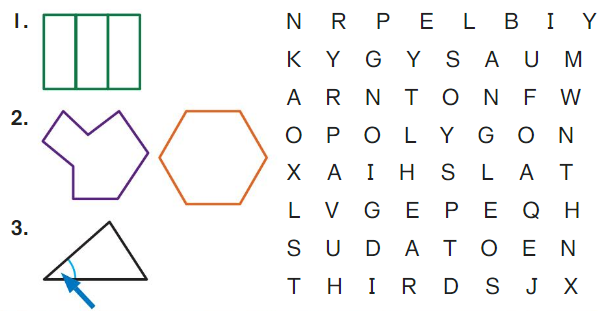


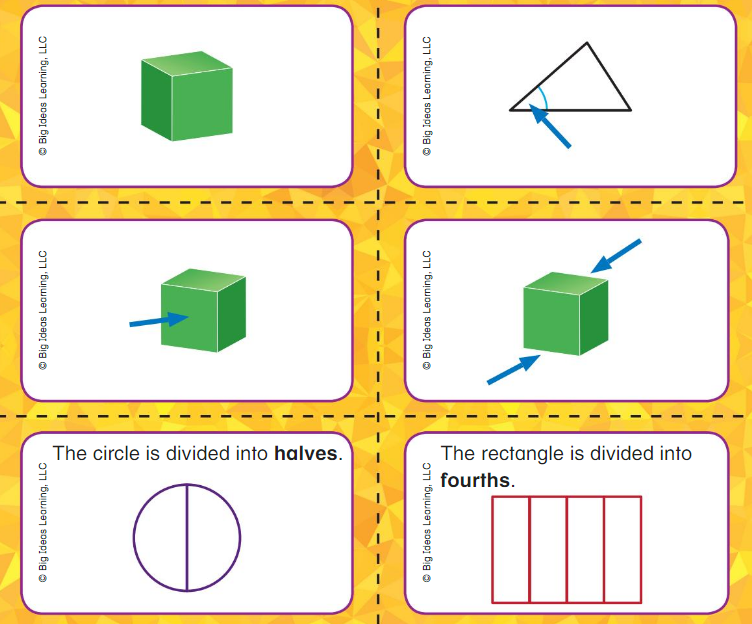

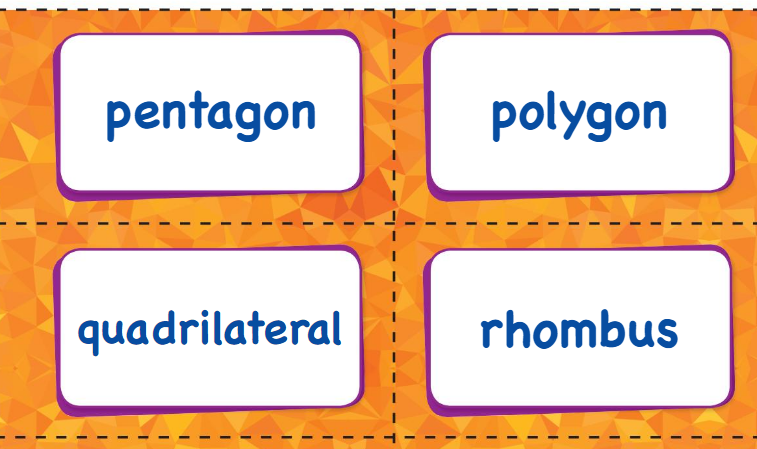

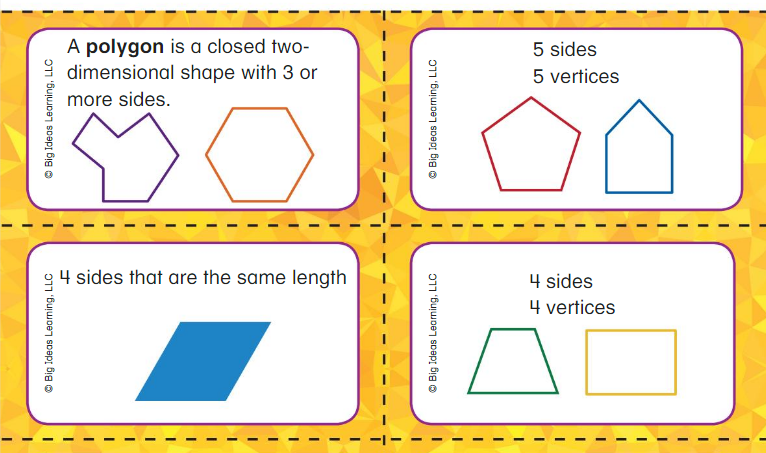
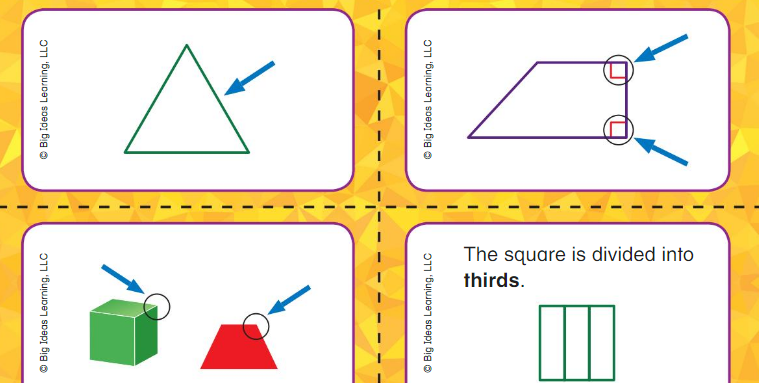
Lesson 15.1 Describe Two-Dimensional Shapes
Explore and Grow
Create a shape with 3 sides on your geoboard. Draw your shape. Did everyone in your class make the same shape?

Circle the word that makes the sentence true.
_______ are shapes with 3 sides.
Circles Squares Triangles
Answer: Triangles
Show and Grow
Question 1.

______ sides
_______ vertices
Shape : _________
Answer: 4 sides
4 vertices
Shape: Irregular Quadrilateral
Question 2.
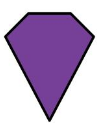
______ sides
_______ vertices
Shape : _________
Answer: 5 sides
5 vertices
Shape: Irregular Pentagon
Apply and Grow: Practice
Question 3.
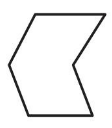
______ sides
_______ vertices
Shape : _________
Answer: 6 sides
6 vertices
Shape: Irregular Hexagon
Question 4.
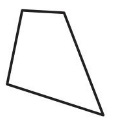
______ sides
_______ vertices
Shape : _________
Answer: 4 sides
4 vertices
Shape: Irregular Quadrilateral
Question 5.
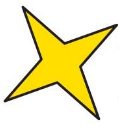
______ sides
_______ vertices
Shape : _________
Answer: 8 sides
8 vertices
Shape: Octagon
Question 6.

______ sides
_______ vertices
Shape : _________
Answer: 3 sides
3 vertices
Shape: Scalene Triangle
Question 7.
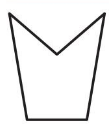
______ sides
_______ vertices
Shape : _________
Answer: 5 sides
5 vertices
Shape: Concave Pentagon
Question 8.
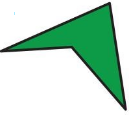
______ sides
_______ vertices
Shape : _________
Answer: 4 sides
4 vertices
Shape: Concave Quadrilateral
Question 9.
Writing
How are a pentagon and an octagon different?
____________________
_____________________
Answer: Pentagon has 5 sides and Octagon has 8 sides.
Think and Grow: Modeling Real Life
Draw a pentagon to make a house. Draw 2 quadrilaterals to make windows and 1 quadrilateral to make a door. Draw an octagon to make a chimney.
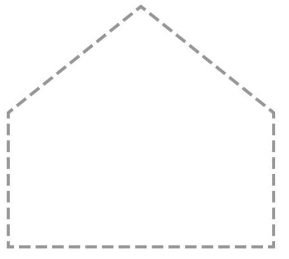
Answer:

Show and Grow
Question 10.
Draw a pentagon to make a fish. Draw 4 triangles to make the fins. Draw a hexagon to make an eye.
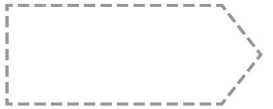
Answer:

Question 11.
You draw 5 quadrilaterals. How many sides and vertices do you draw in all?
______ sides _______ vertices
Answer: 20 sides 20 vertices
Question 12.
DIG DEEPER!
You draw an octagon and two pentagons. How many sides and vertices do you draw in all?
______ sides ______ vertices
Answer: 18 sides 18 vertices
Describe Two-Dimensional Shapes Homework & Practice 15.1
Question 1.
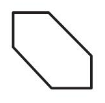
______ sides
_______ vertices
Shape : _________
Answer: 6 sides
6 vertices
Shape: Irregular hexagon
Question 2.

______ sides
_______ vertices
Shape : _________
Answer: 5 sides
5 vertices
Shape: Irregular Pentagon
Question 3.

______ sides
_______ vertices
Shape : _________
Answer: 8 sides
8 vertices
Shape: Irregular Octagon
Question 4.

______ sides
_______ vertices
Shape : _________
Answer: 3 sides
3 vertices
Shape: Right angle Triangle
Question 5.

______ sides
_______ vertices
Shape : _________
Answer: 4 sides
4 vertices
Shape: Quadrilateral
Question 6.
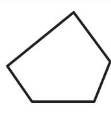
______ sides
_______ vertices
Shape : _________
Answer: 5 sides
5 vertices
Shape: Irregular Pentagon
Question 7.
Precision
Describe the shape in 3 ways.
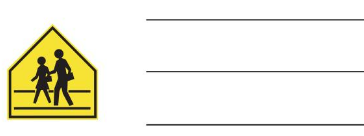
Answer: A 5 sided shape called Pentagon
It has 2 parallel sides
All sides are not equal.
Question 8.
Modeling Real Life
Draw a hexagon to make a dog’s body. Draw quadrilaterals for the head and tail. Draw two triangles for the ears.
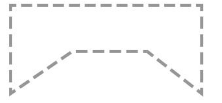
Answer:

Question 9.
DIG DEEPER!
You draw a triangle and two hexagons. How many sides and vertices do you draw in all?
______ sides _______ vertices
Answer: 15 sides 15 vertices
Review & Refresh
Question 10.
You are building a 34-foot fence. You build 15 feet on Saturday and 13 feet on Sunday. How many feet are left to build?
______ feet
Answer: 6 feet are left to build
Explanation: Total 34 foot fence
15 feet on Saturday
13 feet on Sunday
15+13= 28 built
34-28= 6 feet left to build
Lesson 15.2 Identify Angles of Polygons
Explore and Grow
Color the triangle blue. Color the quadrilateral red. Color the pentagon green. Color the hexagon orange.
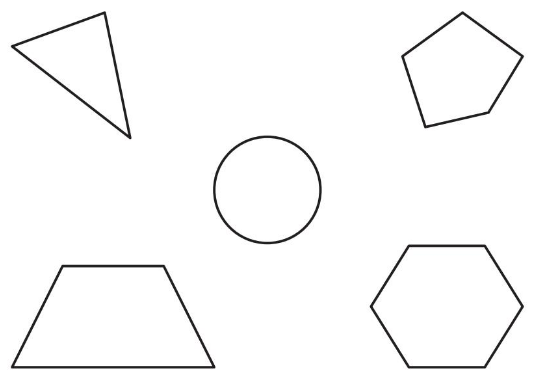
Answer:

Which shape is not colored? How is it different from the other shapes?
________________________
________________________
________________________
Answer: Circle is not colored. Circle has no straight lines.
Show and Grow
Question 1.

_____ angles
How many right angles? ______
Shape: ______
Answer: 6 angles
2 right angles
Shape: Irregular hexagon
Question 2.

______ angles
How many right angles? ______
Shape: _______
Answer: 3 angles
1 right angles
Shape: Right angle triangle
Question 3.

_____ angles
How many right angles? ______
Shape: ______
Answer: 4 angles
4 right angles
Shape: Square
Question 4.

______ angles
How many right angles? ______
Shape : _______
Answer: 4 angles
No right angles
Shape: Trapezium
Apply and Grow: Practice
Question 5.

_____ angles
How many right angles? ______
Shape: ______
Answer: 3 angles
1 right angle
Shape: Right angle triangle
Question 6.

_____ angles
How many right angles? ______
Shape: ______
Answer: 5 angles
2 right angles
Shape: irregular pentagon
Question 7.

_____ angles
How many right angles? ______
Shape: ______
Answer: 8 angles
No right angle
Shape: Irregular Octagon
Question 8.

_____ angles
How many right angles? ______
Shape: ______
Answer: 4 angles
2 right angles
Shape: Irregular Quadrilateral
Question 9.
Draw and name a polygon with 6 angles.
________
Answer:
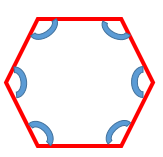
Question 10.
Draw and name a polygon with 2 right angles
_________
Answer:
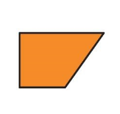
Question 11.
Writing
Can you draw a polygon with 4 sides and 5 angles? Explain.
__________________
____________________
Answer: No, A polygon with 4 sides and 5 angles cannot be drawn as the number of sides and angles are always equal.
Think and Grow: Modeling Real Life
You are designing a road sign. The new sign must be a pentagon with only 2 right angles. Which signs might be yours?

Answer:

Show and Grow
Question 12.
You are making a sign for your lemonade stand. Your sign must be a quadrilateral with 4 right angles. Which signs might be yours?

Answer:

Question 13.
You draw 3 pentagons. How many angles do you draw in all?
______ angles
Answer: 15 angles
Question 14.
DIG DEEPER!
You draw a quadrilateral and three triangles. Your friend draws an octagon and a hexagon. Who draws more angles in all? How many more?
You Friend ______ more angles
Answer: I draw 13 angles in all. My friend draws 14 angles in all. Friend draws more angles in all with 1 more angle.
Identify Angles of Polygons Homework & Practice 15.2
Question 1.

______ angles
How many right angles? ______
Shape: ______
Answer: 6 angles
2 right angles
Shape: Irregular hexagon
Question 2.

______ angles
How many right angles? _____
Shape: ______
Answer: 4 angles
4 right angles
Shape: Rhombus
Question 3.

______ angles
How many right angles? ______
Shape: ______
Answer: 8 angles
No right angles
Shape: Irregular octagon
Question 4.

_____ angles
How many right angles? ______
Shape: _______
Answer: 5 angles
1 right angle
Shape: Irregular pentagon
Question 5.
Draw and name a polygon with 4 sides and 1 right angle.
_______
Answer: Right Quadrilateral

Question 6.
Draw and name a polygon with 6 angles.
________
Answer: Hexagon

Question 7.
DIG DEEPER!
Draw two polygons that have 9 angles in all.
Answer: Triangle and Hexagon
Question 8.
Modeling Real Life
You are designing a company logo. Your logo must be a hexagon with 2 right angles. Which logos might be yours?

Answer:

Question 9.
DIG DEEPER!
You draw an octagon and two triangles. Your friend draws two quadrilaterals and a pentagon. Who draws more angles in all? How many more?
You Friend _______ more angles
Answer: You draw more angles. 1 angle more
You draw 14 angle in total, your friend draw 13 angle in total.
Review & Refresh
Draw to show the time.
Question 10.
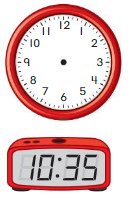
Answer:

Lesson 15.3 Draw Polygons
Explore and Grow
Compare the shapes.

Answer: Sqaure and right Quadrilateral
How are the shapes the same? How are they different?
_____________________
_____________________
_____________________
Answer: Both the shapes have 4 sides and 4 angles
They are different as length of the shapes are not equal.
Show and Grow
Question 1.
Draw a polygon with 6 sides. Two of the sides are the same length.
_______ angles
Polygon: ________
Answer: 6 angles
Polygon: Irregular Hexagon

Question 2.
Draw a polygon with 5 angles. One of the angles is a right angle.
______ sides
Polygon: ________
Answer: 5 sides
Polygon: Irregular Pentagon

Apply and Grow: Practice
Question 3.
Draw a polygon with 3 angles. One of the angles is a right angle.
______ sides
Polygon: _______
Answer: 3 sides
Right angle Triangle
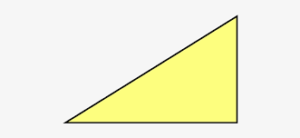
Question 4.
Draw a polygon with 1 more side than a triangle. No sides are equal.
________ sides
Polygon: ______
Answer: 4 sides
Polygon: Irregular Quadrilateral

Question 5.
Draw a polygon with 4 fewer angles than an octagon. All sides are equal. All angles are right angles.
______ sides
Polygon: _______
Answer: 4 sides
Polygon: Square

Question 6.
Draw a polygon with 4 sides. Two pairs of sides are the same length.
______ angles
Polygon: ______
Answer: 4 angles
Polygon: Rectangle
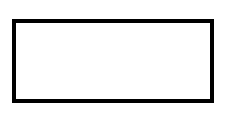
Question 7.
Precision
Which is not a polygon with only 4 angles?
square rectangle rhombus
trapezoid pentagon quadrilateral
Answer: Pentagon
Explanation: Pentagon has 5 angles
Think and Grow: Modeling Real Life
You have 9 straws. You use all the straws to create two polygons. Draw two polygons you can create. Write the names of the polygons.

Polygon 1: ______ Polygon 2: _______
Answer: Polygon 1: Square Polygon 2: Pentagon
Show and Grow
Question 8.
You have 7 clay balls and some toothpicks. You create two polygons using the clay balls as vertices and the toothpicks as sides. Draw two polygons you can create. Write the names of the polygons.
Polygon 1: ______ Polygon 2: _______
Answer: Polygon 1: Triangle Polygon 2: Rhombus
Question 9.
DIG DEEPER!
You draw two different polygons. One of the polygons is a pentagon. You draw 11 sides in all. Draw a possible shape for your other polygon. Write the name of the polygon.
Polygon: _______
Answer: Polygon: Hexagon
Draw Polygons Homework & Practice 15.3
Question 1.
Draw a polygon with 4 angles. There are no right angles. No sides are equal.
______ sides
Polygon: _______
Answer: 4 sides
Polygon: Trapezoid
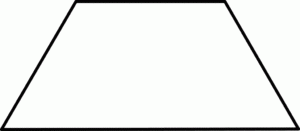
Question 2.
Draw a polygon with 8 sides. Two of the angles are right angles.
_____ angles
Polygon: ______
Answer: 8 angles
Polygon: Irregular octagon
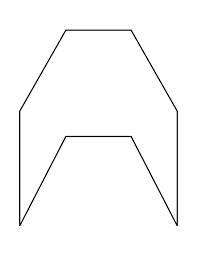
Question 3.
Draw a polygon with 2 more angles than a quadrilateral. Two of the angles are right angles.
______ sides
Polygon: _______
Answer: 6 sides
Polygon: Irregular hexagon

Question 4.
Draw a polygon with 3 fewer sides than an octagon.
_____ angles
Polygon: _____
Answer: 5 angles
Polygon: Pentagon
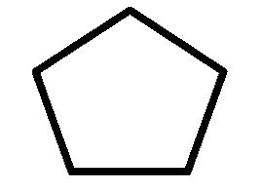
Question 5.
Patterns
Draw 3 shapes. The first shape is a quadrilateral. The number of angles in each shape increases by two.
Name the third shape. ________
Answer: Octagon

Question 6.
Modeling Real Life
You have 9 apples and some sticks. You create two polygons using the apples for vertices and the sticks for sides. Draw two polygons you can create. Write the names of the polygons.
Polygon 1: ______ Polygon 2: ________
Answer: Polygon 1: Sqaure Polygon 2: Pentagon
Question 7.
DIG DEEPER!
You draw two different polygons. One of the polygons is an octagon. You draw 14 sides in all. Draw a possible shape for your other polygon. Write the name of the polygon.
Polygon: ________
Answer: Polygon: Hexagon
Review & Refresh
Question 8.

How many more students chose math than science? _____
Answer: 5 Students
Lesson 15.4 Identify and Draw Cubes
Explore and Grow
Draw an X on the shapes with curved surfaces. Circle the remaining shape with flat surfaces that are all the same.
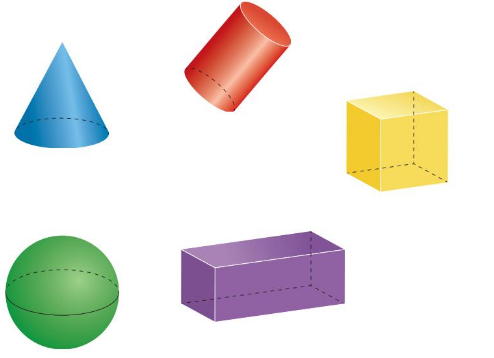
Name the shape you circled.
Answer: Cube, Cuboid

Show and Grow
Question 1.

_____ faces
______ vertices
______ edges
Is it a cube? Yes No
Answer: 6 faces
8 vertices
12 edges
Yes, it is a cube
Question 2.

____ faces
_____ vertices
_______ edges
Is it a cube? Yes No
Answer: 6 faces
8 vertices
12 edges
No, it is not a Cube
Question 3.
Use the dot paper to draw a cube.

Answer: 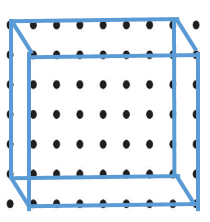
Apply and Grow: Practice
Question 4.
Which shapes are cubes?

Answer: 
Question 5.
Use the dot paper to draw a cube.
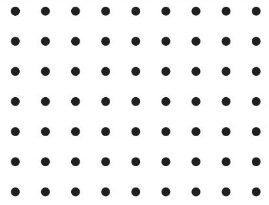
Answer: 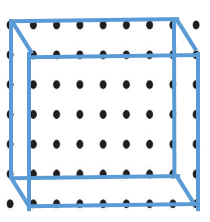
Question 6.
How many faces do two cubes have in all?
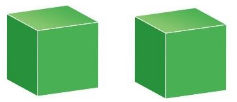
______ faces
Answer: 12 faces
Question 7.
Structure
Which two-dimensional shape makes up a cube? Name the shape.

A cube is made up of ______.
Answer: A cube is made up of Sqaure.
Think and Grow: Modeling Real Life
You make a ballot box for a school election. Your box is in the shape of a cube. Each face of the ballot box is a different color. How many colors do you use?

_____ colors
Answer: 6 colors
Explanation: Cube has 6 faces, So 6 different colors will be used.
Show and Grow
Question 8.
You construct a cube. You use clay balls for the vertices and straws for the edges. How many clay balls do you make? How many straws do you use?

______ clay balls _____ straws
Answer: 8 clay balls 12 straws
Question 9.
The faces of the number cube are numbered, starting with 1. Draw and label all the faces of the number cube.
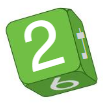
Answer: 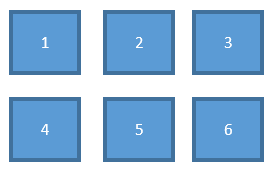
Question 10.
DIG DEEPER!
You have 48 toothpicks and 32 grapes. You use all of the materials to make cubes using the toothpicks as edges and the grapes as vertices. How many cubes do you make?
_____ cubes
Answer: 4 cubes
Identify and Draw Cubes Homework & Practice 15.4
Question 1.
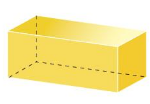
_____ faces
______ vertices
______ edges
Is it a cube? Yes No
Answer: 6 faces
8 vertices
12 edges
No, it is not a cube.
Question 2.
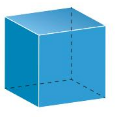
_____ faces
______ vertices
______ edges
Is it a cube? Yes No
Answer: 6 faces
8 vertices
12 edges
Yes, it is a cube
Question 3.
Use the dot paper to draw a cube.
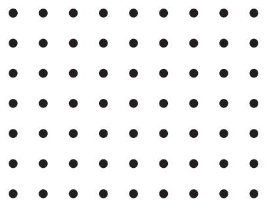
Answer: 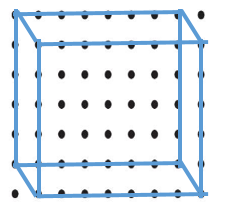
Question 4.
How many vertices do two cubes have in all?

_____ vertices
Answer: 16 vertices
Question 5.
YOU BE THE TEACHER
Newton says the cube has 3 faces. Is he correct? Explain.

___________________
____________________
Answer: Cube has 6 faces
Question 6.
Modeling Real Life
You construct a cube. You use marshmallows for the vertices and pretzel rods for the edges. How many marshmallows do you use? How many pretzel rods do you use?

_______ marshmallows ________ pretzel rods
Answer: 8 marshmallows 12 pretzel rods
Question 7.
DIG DEEPER!
You have 24 cotton balls and 36 toothpicks. You use all of the materials to make cubes using the cotton balls as vertices and the toothpicks as edges. How many cubes do you make?

______ cubes
Answer: 3 cubes
Review & Refresh
Question 8.
43 − 5 = ____
Answer: 38
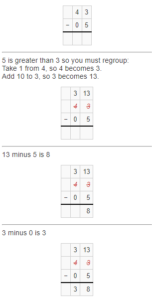
Question 9.
62 − 6 = _____
Answer: 56

Question 10.
______ = 41 − 4
Answer: 37
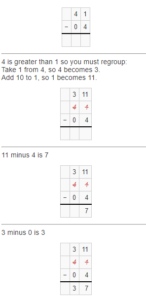
Question 11.
______ = 44 − 7
Answer: 37
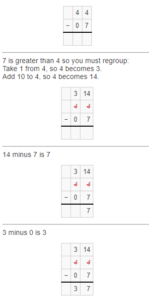
Lesson 15.5 Compose Rectangles
Explore and Grow
How many square tiles do you need to cover the rectangle?
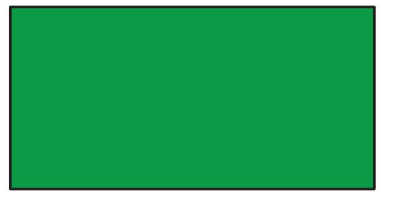
_____ squares
Answer: 28 squares
Write an equation to match your model.
Answer: l × b
7 × 4 = 28
Show and Grow
Question 1.
Use square tiles to cover the rectangle. Draw to show your work.
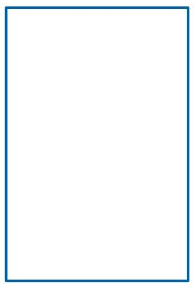
Complete the statements.
Add by rows:
_____ + _____ + = ______
Add by columns: _____ + _____ = ______
Total square tiles: _______
Answer:
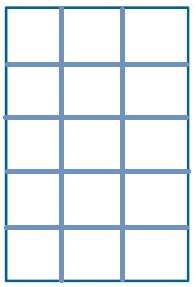
Add by rows:
3 + 3 + 3 + 3 + 3 = 15
Add by columns:
5 + 5 + 5 = 15
Apply and Grow: Practice
Question 2.
Use square tiles to cover the rectangle. Draw to show your work.
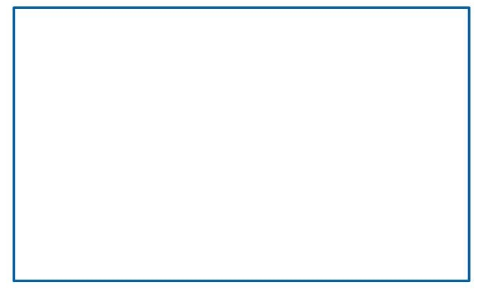
Complete the statements.
Add by rows: _____ + ____ + _____ = ______
Add by columns: ____ + _____ + _____ + ____ + _____ = ______
Total square tiles: ______
Answer:
5 + 5 + 5 = 15
3 + 3 + 3 + 3 + 3 = 15
Question 3.
Precision
Divide the rectangle into 6 equal parts.
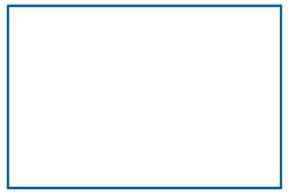
Answer: 
Think and Grow: Modeling Real Life
You use foam mats to cover the entire floor of a square room. You fit 4 mats across one side of the room. How many rows and columns of mats will you have?

_____ rows _____ columns
How many foam mats do you use to cover the entire floor?
Addition equation:
______ foam mats
Answer: 4 rows 4 columns
16 foam mats
Show and Grow
Question 4.
You use square tiles to cover the floor of a square room. You fit 5 tiles across one side of the room. How many rows and columns of tiles will you have?

_____ rows _____ columns
DIG DEEPER!
How many tiles do you use to cover the entire floor?
_____ tiles
Answer: 5 rows 5 columns
25 tiles
Compose Rectangles Homework & Practice 15.5
Question 1.
Use square tiles to cover the rectangle. Draw to show your work.

Complete the statements.
Add by rows: _____ = _____
Total square tiles: ______
Add by columns:
_____ + _____ + _____ + _____ + ______ + _____ = _____
Answer:
1 = 1
1 + 1 + 1 + 1 + 1 + 1 = 6
Question 2.Writing
Newton wants to cover the rectangle with square tiles. Explain what he is doing wrong.
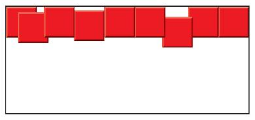
__________________
____________________
Answer: The Square titles are not arranged properly in the rectangle.
Question 3.
Modeling Real Life
You use square glass tiles to make a square mosaic picture. You fit 6 tiles across one side of the picture. How many rows and columns of tiles will you have?

______ rows _______ columns
Answer: 6 rows 6 columns
DIG DEEPER!
How many glass tiles do you use to cover the entire picture?
______ glass tiles
Answer: 36 glass tiles
Review & Refresh
Question 4.
Circle a.m. or p.m.

Answer: 
Lesson 15.6 Identify Two, Three, or Four Equal Shares
Explore and Grow
Sort the Equal Share Cards.
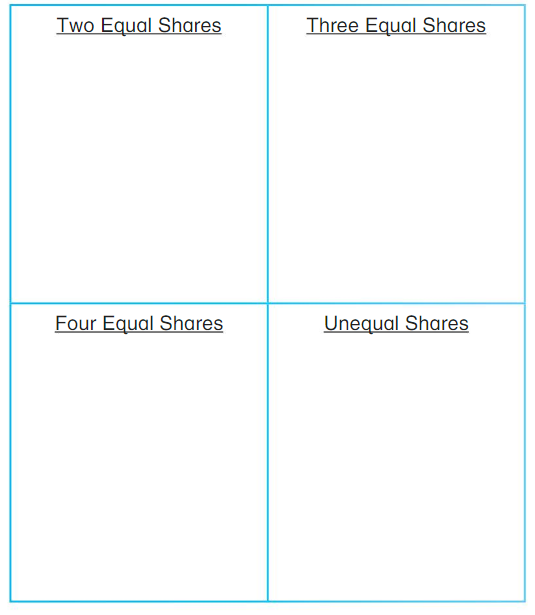
Show and Grow
Circle the shape that shows halves.
Question 1.

Answer: 
Circle the shape that shows thirds.
Question 3.

Answer:

Circle the shape that shows fourths.
Question 5.

Answer:

Apply and Grow: Practice
Question 7.
Which shapes show halves?

Answer:

Question 8.
Which shapes show thirds?

Answer:

Question 9.
Which shapes show fourths?

Answer:

Question 10.
Color a third of the shape.

Answer:

Question 11.
Color half of the shape.

Answer:

Question 12.
Color a fourth of the shape.

Answer:

Question 13.
YOU BE THE TEACHER
Newton says the shape shows fourths. Is he correct? Explain.

________________________
_________________________
Answer: No The shape doesnot shows fourths. The square is not divided into equal parts.
Think and Grow: Modeling Real Life
You want to play 3 games in the pool. Each game needs an equal share of the pool. Show how you could divide the pool.

Answer:
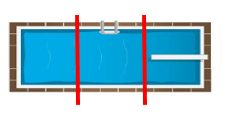
Show and Grow
Question 14.
2 friends are making crafts. Each friend wants an equal share of the table. Show how the friends could divide the table.
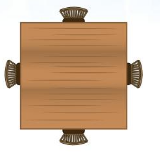
Answer:
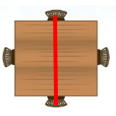
Question 15.
You and 3 friends want to share the piece of watermelon. Show how to cut the piece of watermelon so you and your friends each get an equal share.

How did you know how many equal shares to cut?
__________________
__________________
Answer:

Identify Two, Three, or Four Equal Shares Homework & Practice 15.6
Question 1.
Which shapes show halves?

Answer:

Question 2.
Which shapes show thirds?

Answer:

Question 3.
Which shapes show fourths?

Answer:

Question 4.
Color a third of the shape.

Answer:

Question 5.
Color half of the shape.

Answer:

Question 6.
Color a fourth of the shape.

Answer:

Question 7.
Patterns
Draw what comes next.

Answer:

Question 8.
Modeling Real Life
Newton and Descartes share a bedroom. Show how they could divide their room into equal shares.
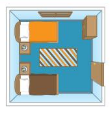
Answer:
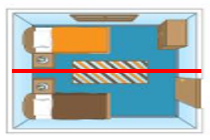
Question 9.
Modeling Real Life
You and 2 friends are making a poster. Each friend wants an equal share of the poster. Show how the friends could divide the poster.

How did you know how many equal shares you need?
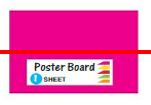
Review & Refresh
Question 10.
A pen is 16 centimeters tall. A pen holder is 11 centimeters tall. How much taller is the pen than the pen holder?
________ centimeters
Answer: 5 centimeters
Explanation: 16-11 = 5
Lesson 15.7 Partition Shapes into Equal Shares
Explore and Grow
Which pattern blocks can you use to model equal shares of the hexagon?

Answer:
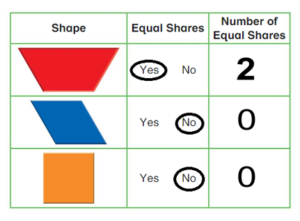
Show and Grow
Draw lines to show equal shares. Complete the sentences.
Question 1.

Each share is a _______ of the whole.
The whole is _______.
Answer:
Each share is a part of the whole.
The whole is 4.
Question 2.

Each share is a _______ of the whole.
The whole is ______.
Answer:
Each share is a half of the whole.
The whole is 2.
Apply and Grow: Practice
Question 3.
Draw lines to show equal shares. Complete the sentences.

Each share is a ______ of the whole.
The whole is ________.
Answer:
Each share is a one third of the whole.
The whole is 1/3.
Draw lines to show equal shares. Which word describes the parts?
Question 4.
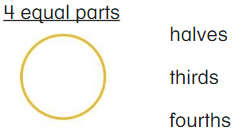
Answer: Fourths
Question 5.
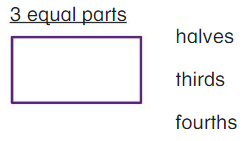
Answer: Thirds
Question 6.
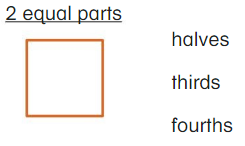
Answer: Halves
Question 7.

Answer: Thirds
Question 8.
Precision
Draw lines to show thirds. Color 3 thirds.

Answer:

Think and Grow: Modeling Real Life
You have 2 towels that are the same size. Half of one towel is green. A fourth of the other towel is yellow. Is the green share or the yellow share larger? Explain.
Draw to show:
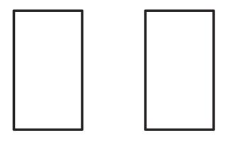
Which share is larger? Green share Yellow share
________________________
________________________
Answer:

Green share
Explanation: First towel is divided into halves and other towel is divided into fourths, So halves is larger than fourths.
Show and Grow
Question 9.
You have 2 rugs that are the same size. A fourth of one rug is red. A third of the other rug is blue. Is the red share or the blue share smaller? Explain.

________________________
________________________
Answer:

The red share is smaller as it is divided into 4 parts.
Partition Shapes into Equal Shares Homework & Practice 15.7
Draw lines to show equal shares. Complete the sentences.
Question 1.
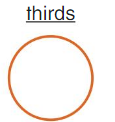
Each share is a ______ of the whole.
The whole is ______.
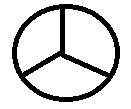 Answer:
Answer:
Question 2.
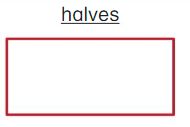
Each share is a _______ of the whole.
The whole is _____.
Answer: 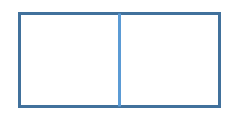
Draw lines to show equal shares. Complete the sentences.
Question 3.

Each share is a ______ of the whole.
The whole is _______.
Answer:
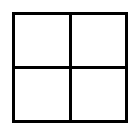
Question 4.
Logic
Complete the sentences.
1 whole is ______ halves.
1 whole is ______ thirds.
1 whole is ______ fourths.
Answer: 1 whole is 2 halves.
1 whole is 3 thirds.
1 whole is 4 fourths.
Question 5.
Structure
Does the shape show thirds? Explain.
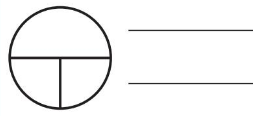
Answer: No, The circle is not divided into 3 equal parts.
Question 6.
Modeling Real Life
You have 2 blankets that are the same size. A third of one blanket is yellow. A half of the other blanket is purple. Is the yellow share or the purple share smaller? Explain.
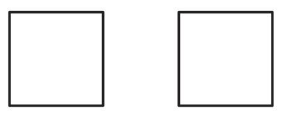
_____________________
_____________________
Answer: The Yellow Share is smaller as the blanket is divided into 3 parts whereas, the purple share is divided into 2 parts.
Review & Refresh
Question 7.
150 + 610 = ______
Answer: 760

Question 8.
553 + 250 = ______
Answer: 803

Lesson 15.8 Analyze Equal Shares of the Same Shape
Explore and Grow
Color the squares that show equal shares.
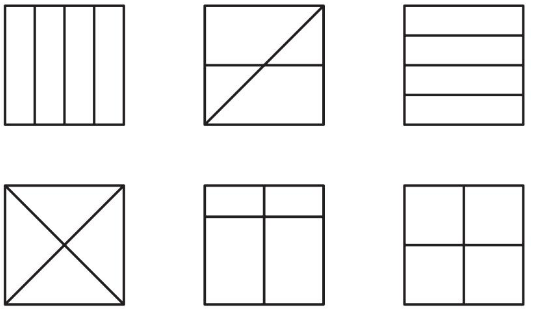
Answer:
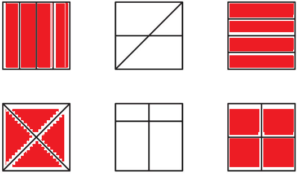
How are the squares you colored the same? How are they different?
________________________
________________________
________________________
Answer: No, the squares colored are not same because all are differently divided.
Show and Grow
Question 1.
Draw lines to show halves in two different ways. Color one-half of each circle.
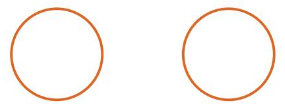
Think: How are the halves of each circle the same? How are they different?
Answer:
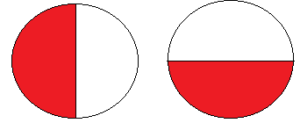
The Circle are divided into 2 parts. The colored part are not same because all are differently divided.
Question 2.
Draw lines to show thirds in two different ways. Color one-third of each rectangle.

Think: How are the thirds of each rectangle the same? How are they different?
Answer:

The Rectangle are divided into 3 parts. The colored part are not same because all are differently divided.
Apply and Grow: Practice
Question 3.
Draw lines to show fourths two different ways. Color one-fourth of each circle.
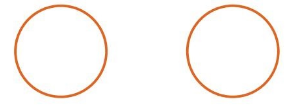
Answer:
Question 4.
Draw lines to show thirds two different ways. Color one-third of each square.
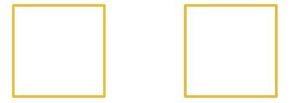
Answer:

Question 5.
Draw lines to show halves two different ways. Color one-half of each rectangle.

Answer:

Question 6.
DIG DEEPER!
Explain how you know each color is a fourth of the whole square.
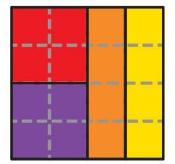
________________________
________________________
_________________________
Answer:
Think and Grow: Modeling Real Life
You and your friend each cut a sandwich into fourths different ways. The sandwiches are the same size. Show how you and your friend can cut the sandwiches.
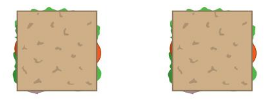
Answer:

Show and Grow
Question 7.
You, Newton, and Descartes each cut a granola bar into halves different ways. The granola bars are the same size. Show how you, Newton, and Descartes can cut the granola bars.

Answer:

Question 8.
DIG DEEPER!
There are 2 pizzas that are the same size. 6 friends each want an equal share of the pizzas. Should the pizzas be cut into halves, thirds, or fourths? Explain.

Answer:

The Pizzas should be cut into thirds as there are 2 pizzas, if one pizza is cut into 3 equal parts and other pizza as 3 equal parts then there is total 6 pieces for 6 friends.
Analyze Equal Shares of the Same Shape Homework & Practice 15.8
Question 1.
Draw lines to show fourths two different ways. Color one-fourth of each rectangle.

Think: How are the fourths of each rectangle the same? How are they different?
Answer:

Question 2.
Draw lines to show thirds two different ways. Color one-third of each circle.

Answer:

Question 3.
Reasoning
Descartes says there are only two ways to divide a rectangle into 3 equal shares. Is he correct? Explain.

Answer:Yes. Descartes is correct. the rectangle can be divided equally horizontally and vertically.
Question 4.
Modeling Real Life
You and your friend each cut a loaf of bread into thirds different ways. The loaves of bread are the same size. Show how you and your friend can cut the loaves of bread.

Answer:
![]()
Question 5.
DIG DEEPER!
There are 2 quesadillas that are the same size. 8 friends each want an equal share of the quesadillas. Should the quesadillas be cut into halves, thirds, or fourths? Explain.

Answer: Fourths
Explanation: There are 2 quesadillas. It can be cut into fourths So, it will be 8 parts in total and given to 8 friends equally.
Review & Refresh
Question 6.
841 − 603 = _____
Answer: 238
Question 7.
439 − 210 = _______
Answer: 229
Identify and Partition Shapes Performance Task
You paint a square suncatcher in art class.
Question 1.
You paint each shape a different color. Color to show how you paint the sun catcher.
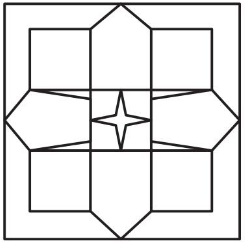
a. Each triangle is red.
b. Each octagon is orange.
c. Each pentagon with more than 1 right angle is yellow.
d. The rest of the pentagons are green.
e. Each shape with 6 angles is blue.
f. Each quadrilateral with all right angles is purple.
g. The rest of the quadrilaterals are pink.
Answer:
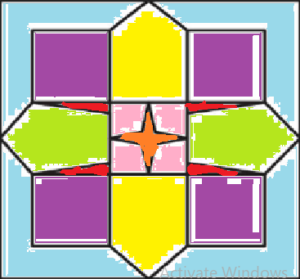
Question 2.
The length of one side of the suncatcher is 12 inches. What are the lengths of the other sides?
______ inches
Answer: 12 inches
Question 3.
Your friend paints a rectangular suncatcher.
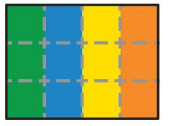
a. What share of your friend’s design is blue? _______
b. What share of your friend’s design is orange or yellow? ________
Answer: a. second
b. third or fourth
Identify and Partition Shapes Activity
Three In a Row: Equal Shares
To Play: Players take turns. On your turn, spin the spinner. Cover a square that matches your spin. Continue playing until a player gets three in a row.
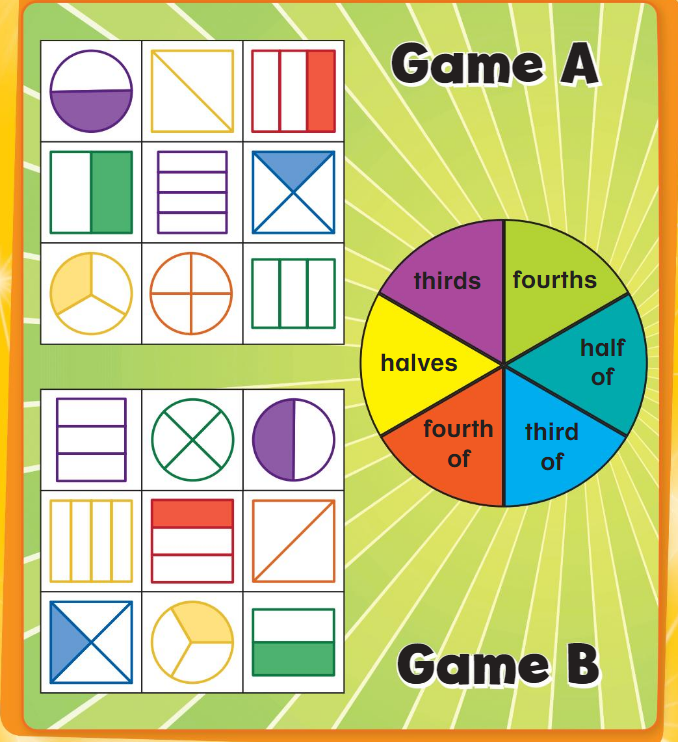
Identify and Partition Shapes Chapter Practice
15.1 Describe Two-Dimensional Shapes
Question 1.

______ sides
_____ vertices
Shape: ______
Answer: 6 sides
6 vertices
Shape: Irregular hexagon
Question 2.

______ sides
_____ vertices
Shape: ______
Answer: 5 sides
5 vertices
Shape: Irregular pentagon
Question 3.
Modeling Real Life
You draw three quadrilaterals and an octagon. How many sides and vertices do you draw in all?
______ sides ______ vertices
Answer: 20 sides 20 vertices
15.2 Identify Angles of Polygons
Question 4.

______ angles
How many right angles? ______
Shape: ______
Answer: 5 angles
2 right angles
Shape: Irregular pentagon
Question 5.

______ angles
How many right angles? ______
Shape: ______
Answer: 6 angles
2 right angles
Shape: Irregular hexagon
Question 6.
Draw and name a shape with 2 right angles.
________
Answer: Pentagon

15.3 Draw Polygons
Question 7.
Draw a polygon with 4 angles. All sides are equal length.
______ sides
Polygon: _______
Answer: 4 sides
Polygon: Square
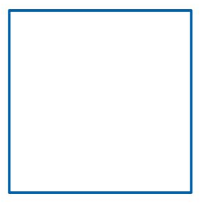
Question 8.
Draw a polygon with 5 sides. Two of the angles are right angles.
______ angles
Polygon: ________
Answer: 5 angles
Polygon: Pentagon

15.4 Identify and Draw Cubes
Question 9.

______ faces
______ vertices
______ edges
Is it a cube? Yes No
Answer: 6 faces
8 vertices
12 edges
Yes it is cube.
Question 10.

______ faces
______ vertices
______ edges
Is it a cube? Yes No
Answer: 6 faces
8 vertices
12 edges
No it is not cube.
Question 11.
Use the dot paper to draw a cube.
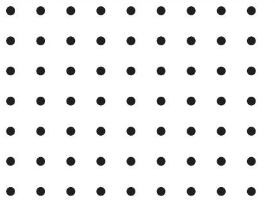
Answer:
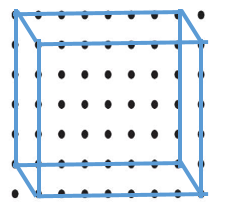
15.5 Compose Rectangles
Question 12.
Use square tiles to cover the rectangle. Draw to show your work.
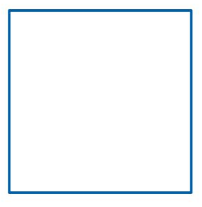
Complete the statements.
Add by rows:
_____ + _____ = ______
Add by columns:
_____ + _____ = _______
Total square tiles: _______
Answer:
Add by rows:
2 + 2 = 4
Add by columns:
2 + 2 = 4
Total square tiles: 4
15.6 Identify Two, Three, or Four Equal Shares
Question 13.
Which shapes show halves?

Answer:
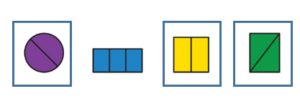
Question 14.
Which shapes show thirds?

Answer:
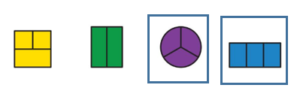
Question 15.
Which shapes show fourths?

Answer:

15.7 Partition Shapes into Equal Shares
Draw lines to show equal parts. Complete the sentences.
Question 16.
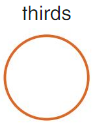
Each share is a ______ of the whole.
The whole is ______.
Answer:
Each share is a fraction or part of the whole.
The whole is 3.
Question 17.
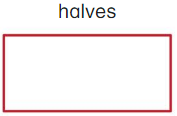
Each share is a ______ of the whole.
The whole is _____.
Answer:
Each share is a part of the whole.
The whole is 2.
Question 18.

Each share is a ______ of the whole.
The whole is _____.
Answer:
Each share is a part of the whole.
The whole is 4.
15.8 Analyze Equal Shares of the Same Shape
Question 19.
Modeling Real Life
There are 3 bagels that are the same size. 6 friends each want an equal share of the bagels. Should the bagels be cut into halves, thirds, or fourths? Explain.

__________________
___________________
Answer:
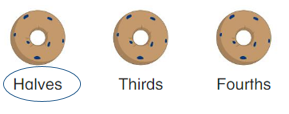
Explanation: 3 bagels cut into Halves will be 6 bagels.
Identify and Partition Shapes Cumulative Practice
Question 1.
Your bed is 39 inches long. Your comforter is 66 inches long. How much longer is the comforter than the bed?

Answer:

Question 2.
Find each difference.
700 – 465 = _____
910 – 186 = _______
302 – 176 = ______
Answer: 700 – 465 = 235
910 – 186 = 724
302 – 176 = 126
Question 3.
A dog park is 48 yards long. Your dog enters the park and runs 29 yards. You run 13 yards. How far is your dog from the other end of the park?

Answer:

Explanation: 29+13=42
48-42=6 yards
Question 4.
Which shapes show thirds?
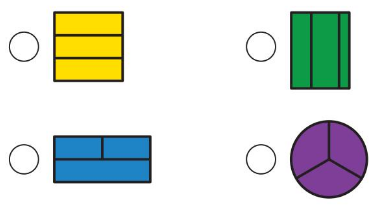
Answer:

Question 5.
The girls’ soccer team raises $237. The boys’ soccer team raises $113 more. How much money do both teams raise in all?

Answer:

Explanation: 237+113=350
Question 6.
Complete the bar graph.

What mascot got the most votes? _______
How many more votes did Warrior get than Tiger? ______
Answer: Knight
3 more votes Warrior get than Tiger.
Question 7.
Count on to find the total value.

Answer: Total value: 91
Question 8.
Which expressions have a difference of 34?

Answer:

Question 9.
Complete the line plot. Then choose all of the statements that are true.

Answer:
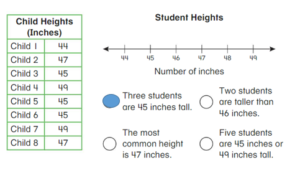
Question 10.
Which clock shows 10:40?
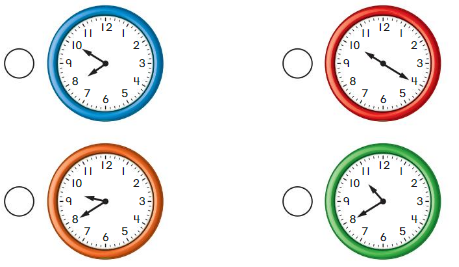
Answer:

Question 11.
The phone is about 12 centimeters long. What is the best estimate for the length of the tablet?

Answer:
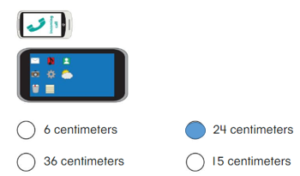
Question 12.

______ sides
_______ vertices
Shape: _____
Answer: 6 sides
6 vertices
Shape: Irregular hexagon
Question 13.

______ sides
_______ vertices
Shape: _______
Answer: 5 sides
5 vertices
Shape: pentagon
Conclusion:
Every expert’s choice is utilizing Big Ideas Math Book 2nd Grade Answer Key Chapter 15 Identify and Partition Shapes PDF. Compare the questions with the real-time problems and solve the problems with the help of Big Ideas Math Answers Grade 2 Chapter 15 Identify and Partition Shapes. Stay tuned to our eurekamathanswerkeys.com to get the all-Big Ideas Math Answers Grade 2 Chapters.


